Paul van Yperen's Blog, page 395
January 5, 2015
Sid Vicious
Sid Vicious (1957-1979) was the legendary bassist of the British punk group the Sex Pistols. He would later appear as a singer on the soundtrack of the documentary The Great Rock 'n' Roll Swindle (Julien Temple, 1978), produced by the Sex Pistols' manager, Malcolm McLaren. In 1979, Vicious died in his sleep, having overdosed on heroin his mother had procured for him. His sudden death at 21 only fuelled his legacy as a punk rock icon.

French postcard, no. 1596.
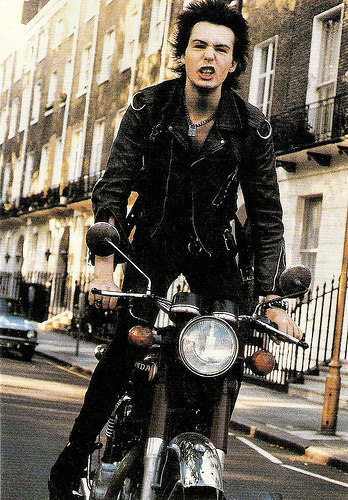
French postcard, no. C 329.
The punk spirit of anarchy and rebellion
Sid Vicious was born John Simon Ritchie, later named John Beverley in Lewisham, South East London, in 1957. His parents were John and Anne Ritchie (née McDonald). His mother dropped out of school early due to a lack of academic success and went on to join the RAF, where she met her husband-to-be, Ritchie's father. He was a guardsman at Buckingham Palace and a semi-professional trombone player on the London Jazz scene.
Shortly after Ritchie's birth, he and his mother moved to Ibiza, where they expected to be joined by his father who, it was planned, would support them financially in the meantime. However, after the first few cheques failed to arrive, Anne realized he would not be coming. In 1965, Anne later married Christopher Beverley, a middle class man, before setting up a family home back in Kent.
Ritchie took his stepfather's surname and was known as John Beverley. Ritchie's stepfather died six months later from cancer, and by 1968 he and his mother were living in a rented flat in Tunbridge Wells, where he attended Sandown Court School. In 1971, the pair moved to Hackney in East-London.
Ritchie first met John Lydon in 1973, when they were both students at Hackney Technical College. By age 17, Ritchie dropped out of school. Hanging around London, he was one of the many disaffected youth to embrace the punk spirit of anarchy and rebellion. One favourite spot was Malcolm McLaren and Vivienne Westwood's then-little-known clothing store, SEX.
John Lydon nicknamed Ritchie ‘Sid Vicious’, after Lydon's pet hamster, Sid. The hamster had bitten Ritchie, who said: "Sid is really vicious!". Another version was that Vicious referred to the famous song by 'rock 'n' roll animal' Lou Reed.
In 1976, Vicious began his musical career as a member of The Flowers of Romance with Keith Levene (who later co-founded Public Image Limited) and Palmolive and Viv Albertine, who would later form The Slits. He also appeared with Siouxsie and the Banshees.
According to Wikipedia, he also appeared as a wild fan in the short film Sex Pistols Number One (Derek Jarman, 1976) with footage of the Pistols when they did a gig at a Valentine’s Day party. Vicious stood out with his Swastika T-shirts, his spiky hair and his 'shock and destroy' attitude.
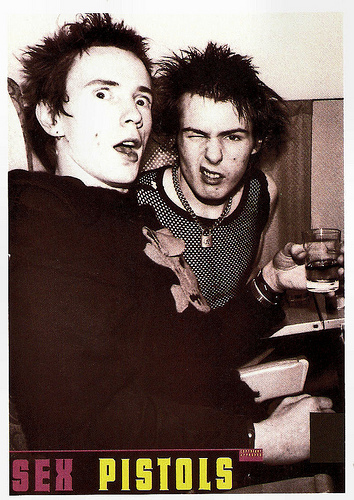
With John Lydon a.k.a. Johnny Rotten. British postcard by Oliver Books Ltd., no. 1.

French postcard by Underground, no. U42.
One of the leading forces in punk music
In February 1977, Sid Vicious joined the Sex Pistols, to replace Glen Matlock, who had fallen out of favour with the rest of the group. Malcolm McLaren had created the Sex Pistols in 1975. One of the leading forces in punk music, the band played fast-paced short songs, expressing angst and frustration about the social and political conditions of the time.
Vicious’ ‘punk’ look had captured the eye of McLaren. Sid played his first gig with the Pistols on 3 April 1977 at The Screen On The Green in London. His debut was filmed and appears in Punk Rock Movie (Don Letts, 1979). The only trouble was that Sid could not play very well and had no bass guitar experience, so guitarist Steve Jones had to step in on bass duties for the bands' debut album Never Mind the Bollocks, Here's the Sex Pistols.
Another reason for his absence for their only studio album is that Vicious was in hospital with hepatitis, due to intravenous drug use. During that period his main visitor was his girlfriend Nancy Spungen, an American groupie and heroin addict. Never Mind the Bollocks went to No. 1 in the British album charts, and the single God Save the Queen reached No. 2. At the end of 1977, the Sex Pistols were one of the most famous bands on the planet with vulgarity and obnoxiousness as well as Sid's hardcore punk personality as the key to their stature.
Spungen and Vicious entered a destructive co-dependent relationship based on drug use. In January, 1978 the group embarked on a US tour which would only last one to two weeks because of multiple show cancellations and deterioration within the group. After the show at Winterland in San Francisco, the group fell apart, and Sid was free to do as he pleased. He recorded lead vocals on three cover songs for the soundtrack of The Great Rock 'n' Roll Swindle.
The Great Rock n' Roll Swindle (Julien Temple, 1980) features famous Vicious footage, such his covers of Frank Sinatra’s My Way and Eddie Cochran’s Somethin' Else, along with various live Sex Pistols footage.
Mark Deming at AllMovie : “This film about the brief but eventful career of The Sex Pistols primarily focuses on McLaren, their manager, as he presents his ten-point program on how to achieve success through chaos, ineptitude, and abusing the music industry. Despite some remarkable footage of The Sex Pistols' infamous Jubilee Day performance and clips from their final concert in San Francisco, there's surprisingly little screen time devoted to the group actually performing.”
But the video of Sid’s rendition of Sinatra’s My Way is a classic. Venue is the Mecca of the chanson, the Olympia in Paris with royalty and elderly bourgeois as the audience. When the red curtain opens, Sid - white tuxedo jacket, torn pants, Doc Martens boots – walks the show stairs. The music starts playing and Sid sings 'Now the end is near / I face the final curtain' like Sinatra in agony, but then the song degenerates in hard rock' n 'roll and the vocals in wild shouting . Vicious moves ever wilder and eventually, he throws his microphone off, grabs a gun from his pants and makes a massacre the public. Vicious turns around; he makes a fuck-you gesture and trudges up the stairs.
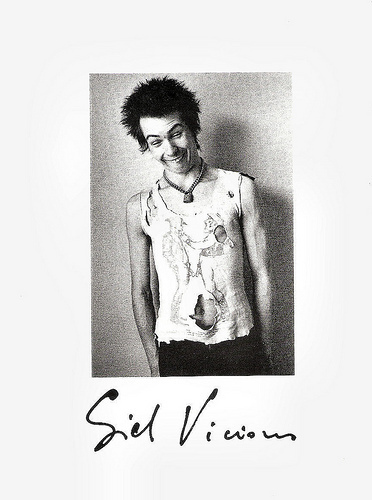
French postcard, no. 902.
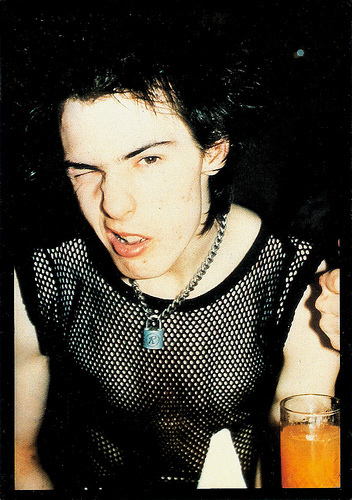
British postcard by Cult Images, no. 10.
Raped, abused, attacked
With Nancy Spungen acting as his manager, Sid Vicious embarked on a solo career. Vicious performed the majority of his performances at Max's Kansas City and drew large crowds. His gigs at Max's would turn out to be his last performances. In October 1978, Spungen died from an apparent stab wound, while staying in the Hotel Chelsea, Manhattan, with Vicious.
On 22 October, ten days after Spungen's death, Vicious attempted suicide by slitting his wrist with a smashed light bulb and was subsequently hospitalized at Bellevue Hospital where he also tried killing himself by jumping from a window. Under suspicion of having committed Spungen's murder and charged with assault after attacking Todd Smith, singer Patti Smith's brother, Vicious was arrested and sent to Rikers Island metro jail for fifty-five days to undergo a painful and enforced detoxification.
It was revealed in the pilot episode of Final 24 that Sid was raped, abused, attacked and subjected to various other humiliating assaults, but no one has reported witnessing these events. He was released on bail. In celebration of his release from prison, Vicious’ mother Anne hosted a party for him. Anne had been supplying Vicious with drugs and paraphernalia since he was young, and assisted him in procuring heroin late that night.
Sid Vicious died in his sleep, having overdosed on the heroin his mother had procured. According to the book Please Kill Me: The Uncensored Oral History of Punk by Legs McNeil and Gillian McCain, Anne scattered Sid's ashes over Nancy Spungen's grave.
Nearly four weeks after Vicious' death, the soundtrack album of The Great Rock 'n' Roll Swindle was released. Later that year, on 15 December 1978, a compilation of live material recorded during his brief solo career was packaged and released as Sid Sings.
In 1986 the British film Love Kills/Sid and Nancy (Alex Cox, 1986). It, portrays the chaotic last phase of their lives, ending with a fictionalised stabbing scene. It starred Gary Oldman as Sid and Chloe Webb as Nancy. Mark Deming at AllMovie : “Sid & Nancy is less about drugs and punk rock than about a relationship. As directed by Alex Cox and enacted by Gary Oldman and Chloe Webb in performances so detailed that they're often difficult to watch, it becomes a heart-wrenching story about two people whose love is doomed from the start -- and who probably wouldn't want it any other way.”
Julien Temple made a second film about The Sex Pistols, The Filth and the Fury (Julien Temple, 2000). His The Great Rock 'n Roll Swindle (1980) was heavily criticised for being too skewed towards the Pistols' manager Malcolm McLaren's version of events. The Filth and the Fury puts the band into historical context with Britain's social situation in the 1970s through archival footage from the period. The Pistols tell their side of the story, mostly through interviews with the surviving members of the group, footage shot during the era, and outtakes from The Great Rock and Roll Swindle.
In 2006, Sid Vicious, along with the four original members of the Sex Pistols, was inducted into the Rock 'n' Roll Hall Of Fame, although the band refused to attend. The British documentary Who Killed Nancy? (Alan Parker, 2009) examines the possibility that it was not Sid Vicious who was responsible for the death of Nancy Spungen. The legend lives on.
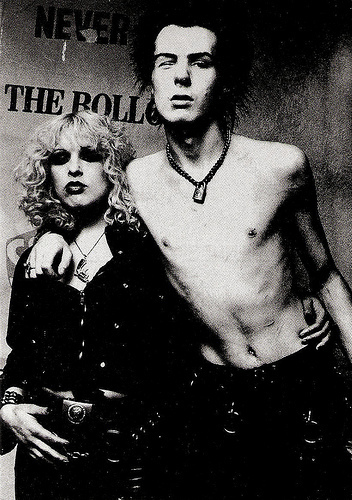
French postcard by Underground, no. 300.
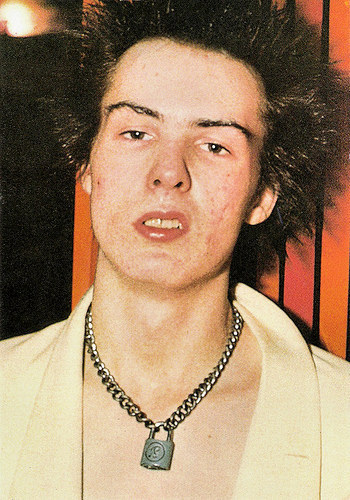
French postcard by Underground, no. 371.
Sid Vicious sings My Way. Source: Luis Asenjo (YouTube).
Trailer Sid & Nancy. Source: MovieTrailerMonkey (YouTube).
Sources: Mark Deming (AllMovie), Rowland Wymer (Derek Jarman), Pieter Steinz (NRC.nl – Dutch), Biography.com, Wikipedia, and .

French postcard, no. 1596.

French postcard, no. C 329.
The punk spirit of anarchy and rebellion
Sid Vicious was born John Simon Ritchie, later named John Beverley in Lewisham, South East London, in 1957. His parents were John and Anne Ritchie (née McDonald). His mother dropped out of school early due to a lack of academic success and went on to join the RAF, where she met her husband-to-be, Ritchie's father. He was a guardsman at Buckingham Palace and a semi-professional trombone player on the London Jazz scene.
Shortly after Ritchie's birth, he and his mother moved to Ibiza, where they expected to be joined by his father who, it was planned, would support them financially in the meantime. However, after the first few cheques failed to arrive, Anne realized he would not be coming. In 1965, Anne later married Christopher Beverley, a middle class man, before setting up a family home back in Kent.
Ritchie took his stepfather's surname and was known as John Beverley. Ritchie's stepfather died six months later from cancer, and by 1968 he and his mother were living in a rented flat in Tunbridge Wells, where he attended Sandown Court School. In 1971, the pair moved to Hackney in East-London.
Ritchie first met John Lydon in 1973, when they were both students at Hackney Technical College. By age 17, Ritchie dropped out of school. Hanging around London, he was one of the many disaffected youth to embrace the punk spirit of anarchy and rebellion. One favourite spot was Malcolm McLaren and Vivienne Westwood's then-little-known clothing store, SEX.
John Lydon nicknamed Ritchie ‘Sid Vicious’, after Lydon's pet hamster, Sid. The hamster had bitten Ritchie, who said: "Sid is really vicious!". Another version was that Vicious referred to the famous song by 'rock 'n' roll animal' Lou Reed.
In 1976, Vicious began his musical career as a member of The Flowers of Romance with Keith Levene (who later co-founded Public Image Limited) and Palmolive and Viv Albertine, who would later form The Slits. He also appeared with Siouxsie and the Banshees.
According to Wikipedia, he also appeared as a wild fan in the short film Sex Pistols Number One (Derek Jarman, 1976) with footage of the Pistols when they did a gig at a Valentine’s Day party. Vicious stood out with his Swastika T-shirts, his spiky hair and his 'shock and destroy' attitude.

With John Lydon a.k.a. Johnny Rotten. British postcard by Oliver Books Ltd., no. 1.

French postcard by Underground, no. U42.
One of the leading forces in punk music
In February 1977, Sid Vicious joined the Sex Pistols, to replace Glen Matlock, who had fallen out of favour with the rest of the group. Malcolm McLaren had created the Sex Pistols in 1975. One of the leading forces in punk music, the band played fast-paced short songs, expressing angst and frustration about the social and political conditions of the time.
Vicious’ ‘punk’ look had captured the eye of McLaren. Sid played his first gig with the Pistols on 3 April 1977 at The Screen On The Green in London. His debut was filmed and appears in Punk Rock Movie (Don Letts, 1979). The only trouble was that Sid could not play very well and had no bass guitar experience, so guitarist Steve Jones had to step in on bass duties for the bands' debut album Never Mind the Bollocks, Here's the Sex Pistols.
Another reason for his absence for their only studio album is that Vicious was in hospital with hepatitis, due to intravenous drug use. During that period his main visitor was his girlfriend Nancy Spungen, an American groupie and heroin addict. Never Mind the Bollocks went to No. 1 in the British album charts, and the single God Save the Queen reached No. 2. At the end of 1977, the Sex Pistols were one of the most famous bands on the planet with vulgarity and obnoxiousness as well as Sid's hardcore punk personality as the key to their stature.
Spungen and Vicious entered a destructive co-dependent relationship based on drug use. In January, 1978 the group embarked on a US tour which would only last one to two weeks because of multiple show cancellations and deterioration within the group. After the show at Winterland in San Francisco, the group fell apart, and Sid was free to do as he pleased. He recorded lead vocals on three cover songs for the soundtrack of The Great Rock 'n' Roll Swindle.
The Great Rock n' Roll Swindle (Julien Temple, 1980) features famous Vicious footage, such his covers of Frank Sinatra’s My Way and Eddie Cochran’s Somethin' Else, along with various live Sex Pistols footage.
Mark Deming at AllMovie : “This film about the brief but eventful career of The Sex Pistols primarily focuses on McLaren, their manager, as he presents his ten-point program on how to achieve success through chaos, ineptitude, and abusing the music industry. Despite some remarkable footage of The Sex Pistols' infamous Jubilee Day performance and clips from their final concert in San Francisco, there's surprisingly little screen time devoted to the group actually performing.”
But the video of Sid’s rendition of Sinatra’s My Way is a classic. Venue is the Mecca of the chanson, the Olympia in Paris with royalty and elderly bourgeois as the audience. When the red curtain opens, Sid - white tuxedo jacket, torn pants, Doc Martens boots – walks the show stairs. The music starts playing and Sid sings 'Now the end is near / I face the final curtain' like Sinatra in agony, but then the song degenerates in hard rock' n 'roll and the vocals in wild shouting . Vicious moves ever wilder and eventually, he throws his microphone off, grabs a gun from his pants and makes a massacre the public. Vicious turns around; he makes a fuck-you gesture and trudges up the stairs.

French postcard, no. 902.

British postcard by Cult Images, no. 10.
Raped, abused, attacked
With Nancy Spungen acting as his manager, Sid Vicious embarked on a solo career. Vicious performed the majority of his performances at Max's Kansas City and drew large crowds. His gigs at Max's would turn out to be his last performances. In October 1978, Spungen died from an apparent stab wound, while staying in the Hotel Chelsea, Manhattan, with Vicious.
On 22 October, ten days after Spungen's death, Vicious attempted suicide by slitting his wrist with a smashed light bulb and was subsequently hospitalized at Bellevue Hospital where he also tried killing himself by jumping from a window. Under suspicion of having committed Spungen's murder and charged with assault after attacking Todd Smith, singer Patti Smith's brother, Vicious was arrested and sent to Rikers Island metro jail for fifty-five days to undergo a painful and enforced detoxification.
It was revealed in the pilot episode of Final 24 that Sid was raped, abused, attacked and subjected to various other humiliating assaults, but no one has reported witnessing these events. He was released on bail. In celebration of his release from prison, Vicious’ mother Anne hosted a party for him. Anne had been supplying Vicious with drugs and paraphernalia since he was young, and assisted him in procuring heroin late that night.
Sid Vicious died in his sleep, having overdosed on the heroin his mother had procured. According to the book Please Kill Me: The Uncensored Oral History of Punk by Legs McNeil and Gillian McCain, Anne scattered Sid's ashes over Nancy Spungen's grave.
Nearly four weeks after Vicious' death, the soundtrack album of The Great Rock 'n' Roll Swindle was released. Later that year, on 15 December 1978, a compilation of live material recorded during his brief solo career was packaged and released as Sid Sings.
In 1986 the British film Love Kills/Sid and Nancy (Alex Cox, 1986). It, portrays the chaotic last phase of their lives, ending with a fictionalised stabbing scene. It starred Gary Oldman as Sid and Chloe Webb as Nancy. Mark Deming at AllMovie : “Sid & Nancy is less about drugs and punk rock than about a relationship. As directed by Alex Cox and enacted by Gary Oldman and Chloe Webb in performances so detailed that they're often difficult to watch, it becomes a heart-wrenching story about two people whose love is doomed from the start -- and who probably wouldn't want it any other way.”
Julien Temple made a second film about The Sex Pistols, The Filth and the Fury (Julien Temple, 2000). His The Great Rock 'n Roll Swindle (1980) was heavily criticised for being too skewed towards the Pistols' manager Malcolm McLaren's version of events. The Filth and the Fury puts the band into historical context with Britain's social situation in the 1970s through archival footage from the period. The Pistols tell their side of the story, mostly through interviews with the surviving members of the group, footage shot during the era, and outtakes from The Great Rock and Roll Swindle.
In 2006, Sid Vicious, along with the four original members of the Sex Pistols, was inducted into the Rock 'n' Roll Hall Of Fame, although the band refused to attend. The British documentary Who Killed Nancy? (Alan Parker, 2009) examines the possibility that it was not Sid Vicious who was responsible for the death of Nancy Spungen. The legend lives on.

French postcard by Underground, no. 300.

French postcard by Underground, no. 371.
Sid Vicious sings My Way. Source: Luis Asenjo (YouTube).
Trailer Sid & Nancy. Source: MovieTrailerMonkey (YouTube).
Sources: Mark Deming (AllMovie), Rowland Wymer (Derek Jarman), Pieter Steinz (NRC.nl – Dutch), Biography.com, Wikipedia, and .
Published on January 05, 2015 22:00
January 4, 2015
Hildegard Knef
Rebellious, gravel-voiced actress, chanteuse and author Hildegard Knef (1925-2002) was one of the most important film stars of post-war Germany. She also appeared in foreign films and on Broadway, billed as Hildegard(e) Neff. Her outspokenness often caused unease in a country eager to please. Germany’s sole diva lead a roller coaster life full of successes and sufferings.
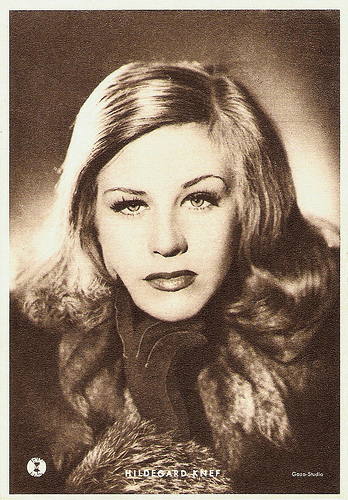
German postcard by Kunst und Bild, Frankfurt-Main. Photo: Gaza-studio.
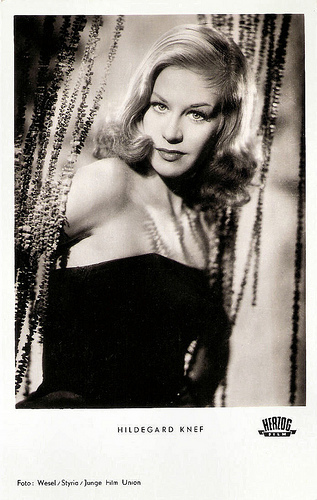
German postcard by Kunst und Bild, Berlin, no. A 482. Photo: Wesel / Styria / Junge Film Union / Herzog Film. Publicity still for Die Sünderin/The Sinner (Willi Forst, 1950).
Berlin's Voice
Hildegard Frieda Albertine Knef was born in Ulm, Germany, in 1925. Her parents were the Flemish tobacco merchant Hans Theodor Knef and his german wife Frieda Auguste Knef-Gröhn. Hildegard went to school to the Rückert-Lyzeum in Berlin-Schöneberg.
In 1942, she began to work as an artist at the painting department of the Ufa Film studio. A year later, she made a screentest and became an acting student at the Babelsberg Film Institute, Ufa's training program.
Even before the fall of the Third Reich she appeared in several films, including Die Brüder Noltenius/The Noltenius Brothers (Gerhard Lamprecht, 1945), Unter den Brücken/Under the Bridges (Helmut Käutner, 1945), and Frühlingsmelodie/Spring Melody (Hans Robert Bortfeld, 1945), but most were released after the war.
To avoid being raped by the Soviet soldiers she dressed like a young man and was subsequently sent to a camp for prisoners of war. She escaped and returned to war-shattered Berlin where she played her first part on stage in the cabaret show Heute Abend um sechs (Tonight at Six) with Viktor de Kowa .
She had her breakthrough in the first film released after World War II in East Germany, Die Mörder sind unter uns/The Murderers Are Among Us (Wolfgang Staudte, 1946), produced by the communist DEFA-Studio, backed by the Russians. Her powerful performance as a Holocaust survivor amid the ruins of postwar Berlin made her immediately a star. Over 4 million East-Germans went to the cinema to see it.
She appeared also in the first West-German films Zwischen gestern und morgen/Between Yesterday and Tomorrow (Harald Braun, 1947) and Film ohne Titel/Film Without a Name (Rudolf Jugert, 1947) with Hans Söhnker , both backed by the Americans.
In these films she symbolized war-shattered Germany and became ‘Berlin’s voice’ — learning to survive, stubbornly bouncing back and starting anew, without ever losing sight of the past. Film ohne Titel/Film Without a Name became commercially the most successful film of 1948 in West-Germany.
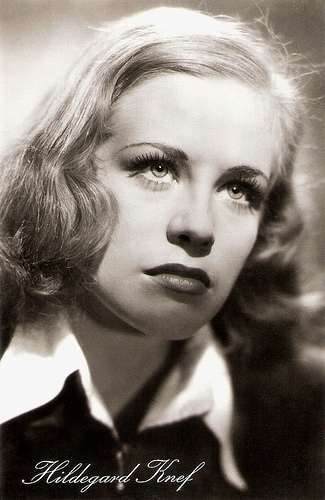
German postcard for Die Mürder sind unter uns/Murderers Among Us (Wolfgang Staudte, 1946) by VEB Progress Film-Vertrieb, Berlin. Photo: DEFA, no. 14 M/300.
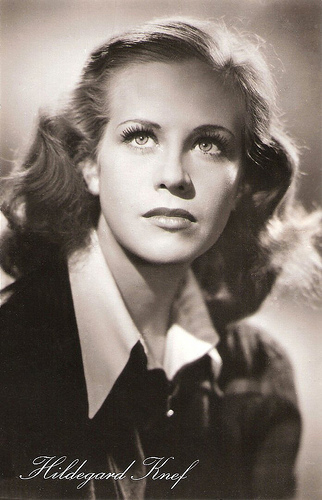
East-German postcard by VEB Progress Film-Vertrieb, Berlin, no. 7/319. 1957. Photo: DEFA.
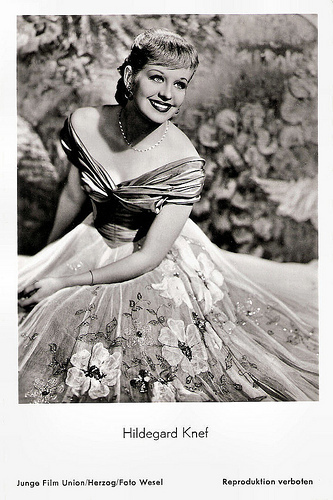
German postcard by F.J. Rüdel Filmpostkartenverlag, Hamburg-Bergedorf, no. 81/2. Photo: Junge Film Union / Herzog / Foto Wesel.
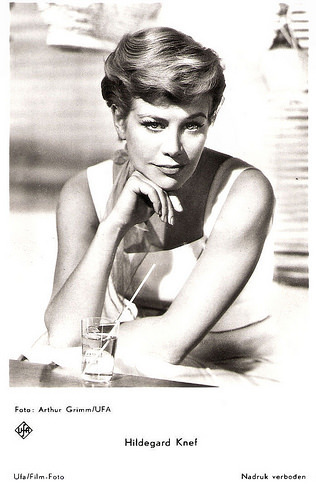
Dutch postcard by D.R.C. Holland, no. 3630. Photo: Arthur Grimm / Ufa.
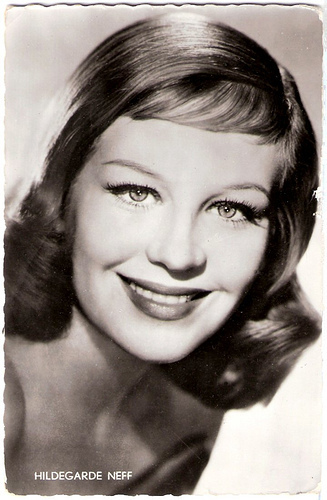
Dutch postcard by N.V. Int. Filmpers, Amsterdam, no. 1056.
Nude Scene
In 1948 Hildegard Knef appeared on a cover of Life magazine and studio mogul David O. Selznick of 20th Century-Fox invited her to come to Hollywood. He offered her a contract - with two conditions: she should change her name into Gilda Christian and should pretend to be Austrian instead of German. She refused both and returned temporarily to Germany.
There she appeared in another influential role, Marina in Die Sünderin/The Sinner (Willi Forst, 1950), in which she performed the first (brief) nude scene of the German cinema. The incident sparked one of the largest scandals in the German film history and drew the criticism of the Roman Catholic Church, but also 7 million spectators. Her comment: "I can't understand all that tumult - five years after Auschwitz!"
During the 1950s she became an internationally active star, who travelled between the USA and Europe. She appeared in minor roles in Hollywood productions like Decision Before Dawn (Anatole Litvak, 1951), Diplomatic Courier (Henry Hathaway, 1952) starring Tyrone Power, Ernest Hemingway's The Snows of Kilimanjaro (Henry King, 1952) starring Gregory Peck, and the film noir Night Without Sleep (Roy Ward Baker, 1952). In these films she was billed as Hildegarde Neff, reportedly because Americans couldn't pronounce Knef.
She also starred in such European films as Nachts auf den Straßen/Nights on the Road (Rudolf Jugert, 1951) with Hans Albers , Alraune/Mandrake (Arthur Maria Rabenalt, 1952) opposite Erich von Stroheim , the French production La fête à Henriette/Holiday for Henrietta (Julien Duvivier, 1952), Illusion in Moll/Illusion in a Minor Key (Rudolf Jugert, 1952) with Sybille Schmitz , the thriller The Man Between (Carol Reed, 1953) starring James Mason , and the flop Madeleine und der Legionär/Escape from Sahara (Wolfgang Staudte, 1958) with Bernhard Wicki .
In total she would appear in 49 feature films, 19 of which were non-German productions. She was also successful on stage, appearing in 15 plays. Her Broadway debut as Ninotchka in Cole Porter’s Silk Stockings (1955-1956) is considered her greatest triumph – as she became the first German to succeed on Broadway. The New York Times wrote about her: "She gives an immensely skilful performance".
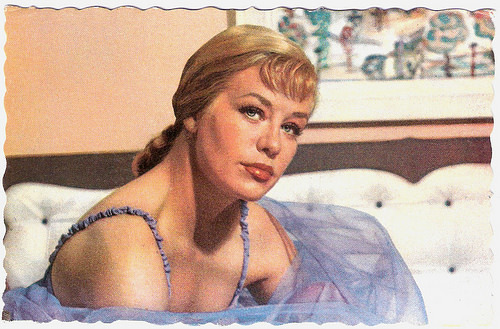
French postcard by De Marchi Frères, Marseille.
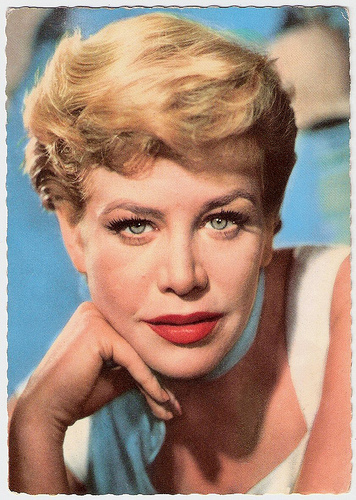
German postcard by Universum-Film Aktiengesellschaft (Ufa), Berlin-Tempelhof, no. CK-96. Retail price: 30 Pfg. Photo: Arthur Grimm / Ufa.
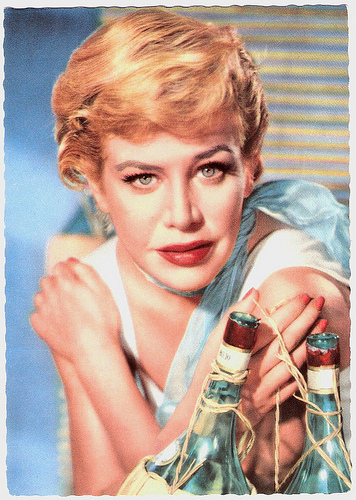
German postcard by Ufa, Berlin-Tempelhof, no. CK-94. Photo: Arthur Grimm / Ufa.
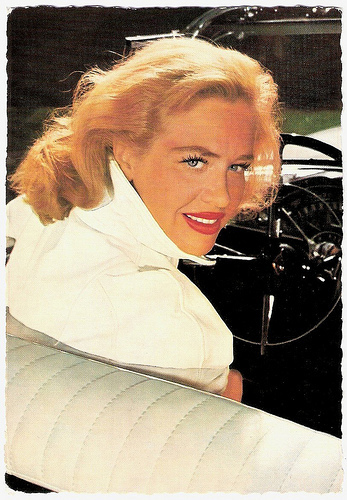
German postcard by WS-Druck, Wanne-Eickel, no. F 37. Photo: Klaus Collignon.
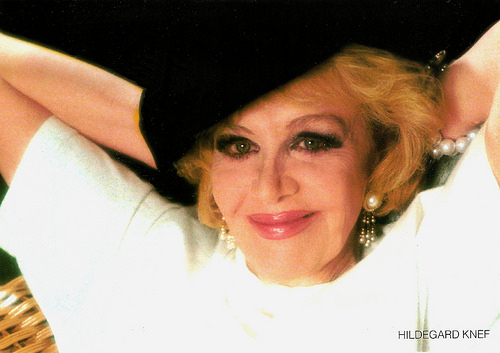
German postcard by Rüdel Verlag, Hamburg. Photo: Lothar Winkler, Berlin.
Breast Cancer
In the 1960s and 1970s, Hildegard Knef enjoyed success as a singer of German chansons, which she often co-wrote. The song she is best remembered for is Für mich soll's rote Rosen regnen (It shall rain red roses for me). She is also known for her version of the song Ich hab noch einen Koffer in Berlin (I`ve got a suitcase left in Berlin...), the title of which is still often cited in articles and in common speech throughout Germany.
Among her other film credits was as Pirate Jenny in a new version of Die Dreigroschenoper/The Threepenny Opera (Wolfgang Staudte, 1962), as victim of a serial killer in the black comedy Landru (Claude Chabrol, 1963), and as Catherine the Great in Caterina di Russia/Catherine of Russia (Umberto Lenzi, 1963).
She was sometimes compared to Marlene Dietrich , in that they both were, or were portrayed as, the liberated, self-confident woman. In Fedora (Billy Wilder, 1979) she played a character based on Dietrich and other legendary film stars.
Besides acting, Hildegard Knef has published seven books. Her autobiography Der geschenkte Gaul - Bericht aus einem Leben/The Gift Horse - Report of a Life from 1970 is a candid, but not sensationalist, recount of her life in Germany during and after World War II. It became the best selling German book after World War II.
Her second book Das Urteil/The Verdict from 1975 was a moderate success. It was a no-nonsense account of her struggle with breast cancer.
In 1999 her last film hit the screens, Eine fast perfekte Hochzeit/An Almost Perfect Wedding (Reinhard Schwabenitzky, 1999). That same year her last album was released, 17 Millimeter, and she gave her last TV appearance, singing Zum Schluss... (At the end…) on the German TV show Herman & Tietjen.
Hildegard Knef endured more than 50 operations but her cancer-ridden and alcohol-wrecked body always bounced back. In 2002 she finally gave in. Aged 76, she died in Berlin, the city where she had moved back to after the German reunification.
Her marriages to the American Kurt Hirsch and British actor David Cameron had ended in divorce. She was survived by her third husband, Paul von Schell, and her daughter with David Cameron, Christina (Tinta) Knef (1968).
German Trailer The Man Between (1953). Source: Retrotrailer (YouTube).
Hildegard Knef sings Ich wollte dich vergessen (I Wanted to Forget You) in the film Um 8 fängt unser Leben an. Source: Rongart (YouTube).
Hildegard Knef sings Goodbye Johnny. Source: 00Plasmaa00 (YouTube).
Hildegard Knef sings Für mich soll's rote Rosen regnen.Source: Master2Dam (YouTube).
Trailer Hilde (2009) with Heike Makatsch als Hildegard Knef. Source: HILDE der Film - offizieller Youtube Channel (YouTube).
Sources: Hal Erickson (AllMovie), (IMDb), World Press Review, BBC News, Hildegardknef.de (German), Wikipedia, and .

German postcard by Kunst und Bild, Frankfurt-Main. Photo: Gaza-studio.

German postcard by Kunst und Bild, Berlin, no. A 482. Photo: Wesel / Styria / Junge Film Union / Herzog Film. Publicity still for Die Sünderin/The Sinner (Willi Forst, 1950).
Berlin's Voice
Hildegard Frieda Albertine Knef was born in Ulm, Germany, in 1925. Her parents were the Flemish tobacco merchant Hans Theodor Knef and his german wife Frieda Auguste Knef-Gröhn. Hildegard went to school to the Rückert-Lyzeum in Berlin-Schöneberg.
In 1942, she began to work as an artist at the painting department of the Ufa Film studio. A year later, she made a screentest and became an acting student at the Babelsberg Film Institute, Ufa's training program.
Even before the fall of the Third Reich she appeared in several films, including Die Brüder Noltenius/The Noltenius Brothers (Gerhard Lamprecht, 1945), Unter den Brücken/Under the Bridges (Helmut Käutner, 1945), and Frühlingsmelodie/Spring Melody (Hans Robert Bortfeld, 1945), but most were released after the war.
To avoid being raped by the Soviet soldiers she dressed like a young man and was subsequently sent to a camp for prisoners of war. She escaped and returned to war-shattered Berlin where she played her first part on stage in the cabaret show Heute Abend um sechs (Tonight at Six) with Viktor de Kowa .
She had her breakthrough in the first film released after World War II in East Germany, Die Mörder sind unter uns/The Murderers Are Among Us (Wolfgang Staudte, 1946), produced by the communist DEFA-Studio, backed by the Russians. Her powerful performance as a Holocaust survivor amid the ruins of postwar Berlin made her immediately a star. Over 4 million East-Germans went to the cinema to see it.
She appeared also in the first West-German films Zwischen gestern und morgen/Between Yesterday and Tomorrow (Harald Braun, 1947) and Film ohne Titel/Film Without a Name (Rudolf Jugert, 1947) with Hans Söhnker , both backed by the Americans.
In these films she symbolized war-shattered Germany and became ‘Berlin’s voice’ — learning to survive, stubbornly bouncing back and starting anew, without ever losing sight of the past. Film ohne Titel/Film Without a Name became commercially the most successful film of 1948 in West-Germany.

German postcard for Die Mürder sind unter uns/Murderers Among Us (Wolfgang Staudte, 1946) by VEB Progress Film-Vertrieb, Berlin. Photo: DEFA, no. 14 M/300.

East-German postcard by VEB Progress Film-Vertrieb, Berlin, no. 7/319. 1957. Photo: DEFA.

German postcard by F.J. Rüdel Filmpostkartenverlag, Hamburg-Bergedorf, no. 81/2. Photo: Junge Film Union / Herzog / Foto Wesel.

Dutch postcard by D.R.C. Holland, no. 3630. Photo: Arthur Grimm / Ufa.

Dutch postcard by N.V. Int. Filmpers, Amsterdam, no. 1056.
Nude Scene
In 1948 Hildegard Knef appeared on a cover of Life magazine and studio mogul David O. Selznick of 20th Century-Fox invited her to come to Hollywood. He offered her a contract - with two conditions: she should change her name into Gilda Christian and should pretend to be Austrian instead of German. She refused both and returned temporarily to Germany.
There she appeared in another influential role, Marina in Die Sünderin/The Sinner (Willi Forst, 1950), in which she performed the first (brief) nude scene of the German cinema. The incident sparked one of the largest scandals in the German film history and drew the criticism of the Roman Catholic Church, but also 7 million spectators. Her comment: "I can't understand all that tumult - five years after Auschwitz!"
During the 1950s she became an internationally active star, who travelled between the USA and Europe. She appeared in minor roles in Hollywood productions like Decision Before Dawn (Anatole Litvak, 1951), Diplomatic Courier (Henry Hathaway, 1952) starring Tyrone Power, Ernest Hemingway's The Snows of Kilimanjaro (Henry King, 1952) starring Gregory Peck, and the film noir Night Without Sleep (Roy Ward Baker, 1952). In these films she was billed as Hildegarde Neff, reportedly because Americans couldn't pronounce Knef.
She also starred in such European films as Nachts auf den Straßen/Nights on the Road (Rudolf Jugert, 1951) with Hans Albers , Alraune/Mandrake (Arthur Maria Rabenalt, 1952) opposite Erich von Stroheim , the French production La fête à Henriette/Holiday for Henrietta (Julien Duvivier, 1952), Illusion in Moll/Illusion in a Minor Key (Rudolf Jugert, 1952) with Sybille Schmitz , the thriller The Man Between (Carol Reed, 1953) starring James Mason , and the flop Madeleine und der Legionär/Escape from Sahara (Wolfgang Staudte, 1958) with Bernhard Wicki .
In total she would appear in 49 feature films, 19 of which were non-German productions. She was also successful on stage, appearing in 15 plays. Her Broadway debut as Ninotchka in Cole Porter’s Silk Stockings (1955-1956) is considered her greatest triumph – as she became the first German to succeed on Broadway. The New York Times wrote about her: "She gives an immensely skilful performance".

French postcard by De Marchi Frères, Marseille.

German postcard by Universum-Film Aktiengesellschaft (Ufa), Berlin-Tempelhof, no. CK-96. Retail price: 30 Pfg. Photo: Arthur Grimm / Ufa.

German postcard by Ufa, Berlin-Tempelhof, no. CK-94. Photo: Arthur Grimm / Ufa.

German postcard by WS-Druck, Wanne-Eickel, no. F 37. Photo: Klaus Collignon.

German postcard by Rüdel Verlag, Hamburg. Photo: Lothar Winkler, Berlin.
Breast Cancer
In the 1960s and 1970s, Hildegard Knef enjoyed success as a singer of German chansons, which she often co-wrote. The song she is best remembered for is Für mich soll's rote Rosen regnen (It shall rain red roses for me). She is also known for her version of the song Ich hab noch einen Koffer in Berlin (I`ve got a suitcase left in Berlin...), the title of which is still often cited in articles and in common speech throughout Germany.
Among her other film credits was as Pirate Jenny in a new version of Die Dreigroschenoper/The Threepenny Opera (Wolfgang Staudte, 1962), as victim of a serial killer in the black comedy Landru (Claude Chabrol, 1963), and as Catherine the Great in Caterina di Russia/Catherine of Russia (Umberto Lenzi, 1963).
She was sometimes compared to Marlene Dietrich , in that they both were, or were portrayed as, the liberated, self-confident woman. In Fedora (Billy Wilder, 1979) she played a character based on Dietrich and other legendary film stars.
Besides acting, Hildegard Knef has published seven books. Her autobiography Der geschenkte Gaul - Bericht aus einem Leben/The Gift Horse - Report of a Life from 1970 is a candid, but not sensationalist, recount of her life in Germany during and after World War II. It became the best selling German book after World War II.
Her second book Das Urteil/The Verdict from 1975 was a moderate success. It was a no-nonsense account of her struggle with breast cancer.
In 1999 her last film hit the screens, Eine fast perfekte Hochzeit/An Almost Perfect Wedding (Reinhard Schwabenitzky, 1999). That same year her last album was released, 17 Millimeter, and she gave her last TV appearance, singing Zum Schluss... (At the end…) on the German TV show Herman & Tietjen.
Hildegard Knef endured more than 50 operations but her cancer-ridden and alcohol-wrecked body always bounced back. In 2002 she finally gave in. Aged 76, she died in Berlin, the city where she had moved back to after the German reunification.
Her marriages to the American Kurt Hirsch and British actor David Cameron had ended in divorce. She was survived by her third husband, Paul von Schell, and her daughter with David Cameron, Christina (Tinta) Knef (1968).
German Trailer The Man Between (1953). Source: Retrotrailer (YouTube).
Hildegard Knef sings Ich wollte dich vergessen (I Wanted to Forget You) in the film Um 8 fängt unser Leben an. Source: Rongart (YouTube).
Hildegard Knef sings Goodbye Johnny. Source: 00Plasmaa00 (YouTube).
Hildegard Knef sings Für mich soll's rote Rosen regnen.Source: Master2Dam (YouTube).
Trailer Hilde (2009) with Heike Makatsch als Hildegard Knef. Source: HILDE der Film - offizieller Youtube Channel (YouTube).
Sources: Hal Erickson (AllMovie), (IMDb), World Press Review, BBC News, Hildegardknef.de (German), Wikipedia, and .
Published on January 04, 2015 22:00
January 3, 2015
Vasily Kachalov
Russian film and stage actor Vasily Kachalov (1875-1948) was one of Konstantin Stanislavsky's best known performers. He led the so-called Kachalov Group within the Moscow Art Theatre. It was Kachalov who played Hamlet in the Symbolist production of 1911. He also appeared in four films.
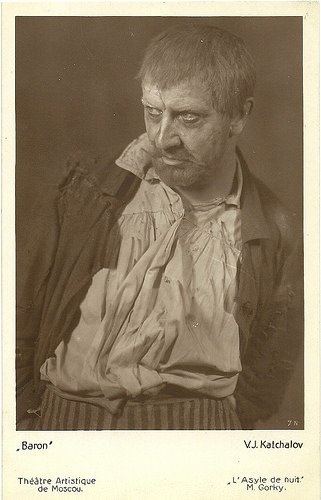
French postcard, no. 7 N. Photo: Moscow Art Theatre. Publicity still for the play Na dne (The Lower Depths - 1902) by Maxim Gorky with Kachalov as the Baron. Collection: Didier Hanson.
Magnetic Voice
Vasily Kachalov (Василий Качалов) was born as Vasili Ivanovich Shverubovich in Vilnius, Russian Empire (now Lithuania), in 1875. His father was Ivan Shverubovich, a Belarusian Orthodox priest from Wilno. His schoolmates at the local college included the future statesman Felix Dzerzhinsky.
In 1896, he left the law department of Saint Petersburg University in order to pursue an acting career. After four years of touring the Russian provinces and a brief stint at the Suvorin Theatre, Kachalov made his debut at the Moscow Art Theatre as Tsar Berendey in Vesennyaya Skazka (The Snow Maiden - 1900) by Alexander Ostrovsky.
The snow maiden was played by Stanislavsky's wife, Maria Lilina, who fell in love with Kachalov. She later described their affair as "a touch of private happiness". Another of his lovers was actress Alisa Koonen. He met his wife, actress Nina Litovtseva, when they were acting in the Kazan Drama Theatre, one of Russia's oldest theatres.
Vasily Kachalov was greatly admired for his ‘magnetic’ voice. He played Baron Tuzenbach in Tri sestry (Three Sisters) by Anton Chekhov after Vsevolod Meyerhold's departure from the theatre. In the original 1904 production of Chekhov’s Vishnyovyy sad (The Cherry Orchard) he appeared as Trofimov. He played Hamlet in the Symbolist Stanislavsky–Craig production of 1911.
Kachalov also performed leading roles in productions directed by Nemirovich-Danchenko. He starred in Nemirovich-Danchenko's production of Chekhov’s Ivanov (1904). He also appeared as the Baron in Gorky's Na dne (The Lower Depths - 1902), as William Shakespeare’s Julius Caesar in 1904, as Henrik Ibsen's Brand in 1906, and as Ivan Karamazov in Fyodor Dostoyevsky‘s Brat'ya Karamazovy (The Brothers Karamazov) in 1910.
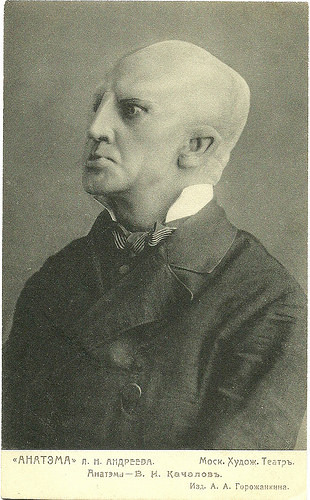
Russian postcard. Kachalov as Anathema in the prologue of the play Anathema (1909) by Leonid Andreev at The Moscow Art Theatre, Moscow, Russia. Collection: Didier Hanson.
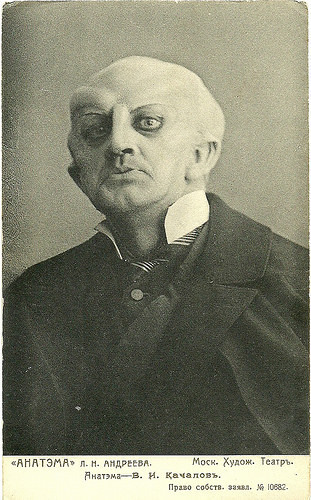
Russian postcard. Kachalov as Anathema in the prologue of the play Anathema (1909) by Leonid Andreev at The Moscow Art Theatre, Moscow, Russia. Collection: Didier Hanson.
The Lost Letter
After the Russian Revolution, the Kachalov Group went touring Central Europe and did not return until the summer of 1921, under pressure from the theatre's founders.
Vasily Kachalov appeared in several films. The silent Soviet film Belyy oryol/The Lash of the Czar (Yakov Protazanov, 1928) is based on a short story by Leonid Andreyev. Kachalov’s co-stars were Anna Sten and Vsevolod Meyerhold.
His other films include the war drama Giorgi Saakadze/Georges Saakadzé (Mikheil Chiaureli, 1942) – in which only his voice is heard - and Mastera stseny/Stars of the Moscow Art Theater (Vladimir Yurenev, 1949).
This anthology film consisted of three segments of famous plays by Maxim Gorky, Alexei Tolstoy and Anton Chekhov. Kachalov appeared as Gayev opposite Olga Knipper-Chekhova in a segment of Chekhov’s Vishnyovyy sad (The Cherry Orchard).
In 1945 he was the narrator of the animation film Propavshaya gramota/The Lost Letter (Valentina Brumberg, Lamis Bredis, Zinaida Brumberg, 1945) based on a novel by Nikolai Gogol.
Kachalov was named one of the first People's Artists of the USSR after the title was instituted in 1936 and received a Stalin Prize in 1943. He was also the recipient of the two Orders of Lenin.
Vasily Kachalov died in 1948 in Moscow, USSR (now Russia). The Kazan State Theatre was given his name later that year.
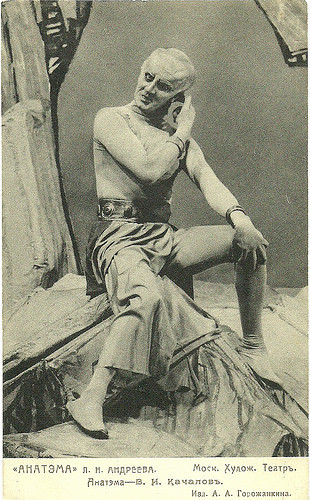
Russian postcard. Photo: K. Fischer, Gorozhankin, Russia. Kachalov as Anathema in the prologue of the play Anathema (1909) by Leonid Andreev at The Moscow Art Theatre, Moscow, Russia. Collection: Didier Hanson.
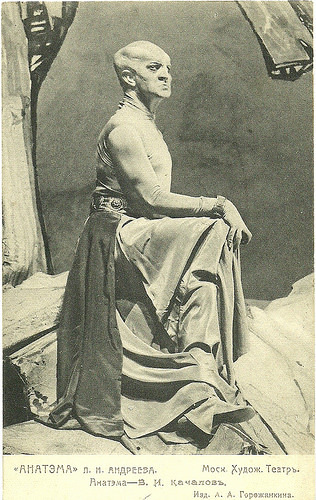
Russian postcard. Photo: K. Fischer, Gorozhankin, Russia. Kachalov as Anathema in the prologue of the play Anathema (1909) by Leonid Andreev at The Moscow Art Theatre, Moscow, Russia. Collection: Didier Hanson.
Sources: Oxford Encyclopedia of Theatre and Performance (Answers.com), Wikipedia (English and French) and .

French postcard, no. 7 N. Photo: Moscow Art Theatre. Publicity still for the play Na dne (The Lower Depths - 1902) by Maxim Gorky with Kachalov as the Baron. Collection: Didier Hanson.
Magnetic Voice
Vasily Kachalov (Василий Качалов) was born as Vasili Ivanovich Shverubovich in Vilnius, Russian Empire (now Lithuania), in 1875. His father was Ivan Shverubovich, a Belarusian Orthodox priest from Wilno. His schoolmates at the local college included the future statesman Felix Dzerzhinsky.
In 1896, he left the law department of Saint Petersburg University in order to pursue an acting career. After four years of touring the Russian provinces and a brief stint at the Suvorin Theatre, Kachalov made his debut at the Moscow Art Theatre as Tsar Berendey in Vesennyaya Skazka (The Snow Maiden - 1900) by Alexander Ostrovsky.
The snow maiden was played by Stanislavsky's wife, Maria Lilina, who fell in love with Kachalov. She later described their affair as "a touch of private happiness". Another of his lovers was actress Alisa Koonen. He met his wife, actress Nina Litovtseva, when they were acting in the Kazan Drama Theatre, one of Russia's oldest theatres.
Vasily Kachalov was greatly admired for his ‘magnetic’ voice. He played Baron Tuzenbach in Tri sestry (Three Sisters) by Anton Chekhov after Vsevolod Meyerhold's departure from the theatre. In the original 1904 production of Chekhov’s Vishnyovyy sad (The Cherry Orchard) he appeared as Trofimov. He played Hamlet in the Symbolist Stanislavsky–Craig production of 1911.
Kachalov also performed leading roles in productions directed by Nemirovich-Danchenko. He starred in Nemirovich-Danchenko's production of Chekhov’s Ivanov (1904). He also appeared as the Baron in Gorky's Na dne (The Lower Depths - 1902), as William Shakespeare’s Julius Caesar in 1904, as Henrik Ibsen's Brand in 1906, and as Ivan Karamazov in Fyodor Dostoyevsky‘s Brat'ya Karamazovy (The Brothers Karamazov) in 1910.

Russian postcard. Kachalov as Anathema in the prologue of the play Anathema (1909) by Leonid Andreev at The Moscow Art Theatre, Moscow, Russia. Collection: Didier Hanson.

Russian postcard. Kachalov as Anathema in the prologue of the play Anathema (1909) by Leonid Andreev at The Moscow Art Theatre, Moscow, Russia. Collection: Didier Hanson.
The Lost Letter
After the Russian Revolution, the Kachalov Group went touring Central Europe and did not return until the summer of 1921, under pressure from the theatre's founders.
Vasily Kachalov appeared in several films. The silent Soviet film Belyy oryol/The Lash of the Czar (Yakov Protazanov, 1928) is based on a short story by Leonid Andreyev. Kachalov’s co-stars were Anna Sten and Vsevolod Meyerhold.
His other films include the war drama Giorgi Saakadze/Georges Saakadzé (Mikheil Chiaureli, 1942) – in which only his voice is heard - and Mastera stseny/Stars of the Moscow Art Theater (Vladimir Yurenev, 1949).
This anthology film consisted of three segments of famous plays by Maxim Gorky, Alexei Tolstoy and Anton Chekhov. Kachalov appeared as Gayev opposite Olga Knipper-Chekhova in a segment of Chekhov’s Vishnyovyy sad (The Cherry Orchard).
In 1945 he was the narrator of the animation film Propavshaya gramota/The Lost Letter (Valentina Brumberg, Lamis Bredis, Zinaida Brumberg, 1945) based on a novel by Nikolai Gogol.
Kachalov was named one of the first People's Artists of the USSR after the title was instituted in 1936 and received a Stalin Prize in 1943. He was also the recipient of the two Orders of Lenin.
Vasily Kachalov died in 1948 in Moscow, USSR (now Russia). The Kazan State Theatre was given his name later that year.

Russian postcard. Photo: K. Fischer, Gorozhankin, Russia. Kachalov as Anathema in the prologue of the play Anathema (1909) by Leonid Andreev at The Moscow Art Theatre, Moscow, Russia. Collection: Didier Hanson.

Russian postcard. Photo: K. Fischer, Gorozhankin, Russia. Kachalov as Anathema in the prologue of the play Anathema (1909) by Leonid Andreev at The Moscow Art Theatre, Moscow, Russia. Collection: Didier Hanson.
Sources: Oxford Encyclopedia of Theatre and Performance (Answers.com), Wikipedia (English and French) and .
Published on January 03, 2015 22:00
January 2, 2015
Un carnet de bal (1937)
In 2015, we continue our weekly series of film specials. Today a post about a poetic French classic, Un carnet de bal/Dance Program (1937), directed by the great Julien Duvivier. Marie Bell plays a woman who goes back in the past, in search of her long lost dance partners.
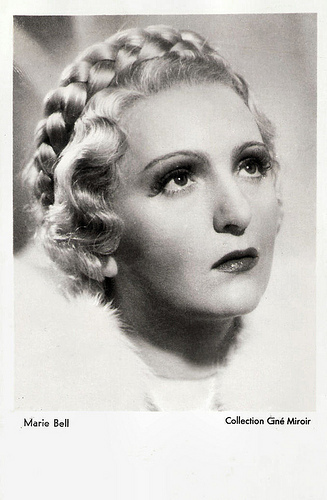
Marie Bell . French postcard. Photo: collection Ciné Miroir.
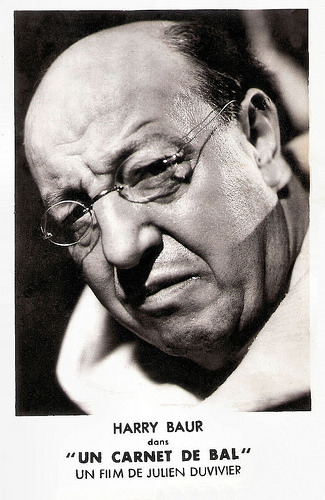
Harry Baur . French postcard by Edition Chantal, Paris. Photo: publicity still for Un Carnet de Bal/Dance Program (Julien Duvivier, 1937).
A turning point in her life
Un Carnet de bal starts romantically on the banks of a fairy tale lake surrounded by mountains, where the still young and rich widow Christine Sugère ( Marie Bell - at the time 37) lives alone after the death of her husband.
She realizes she has possibly wasted her life by marrying the wrong man.
Just for the fun of it, she decides to find out about the men who danced with her during her first ball when she was 16. The ball was a turning point in her life
Following her old Dance Card (carnet de bal), Christine pays a visit to those forgotten dance partners, one by one. She is not only surprised to see how they have fared, but also discovers the impact she had, unknowingly, on the feelings and the destiny of these men.
The dream cast of Un carnet de bal includes such legendary names of the French cinema as Marie Bell , Fernandel , Harry Baur , Louis Jouvet - in one of his best roles, Pierre Blanchar , Raimu , Pierre Richard Willm , Francoise Rosay ... All of them at the peak of their form.
Julien Duvivier created a ‘portmanteau’ film with seven flashbacks, one prologue and a short epilogue. The parts are held together musically by Maurice Jaubert's haunting theme melody, the waltz Valse Grise. The postcards in this post show five of Christine's dance partners, who are all a subject for one of the segments.
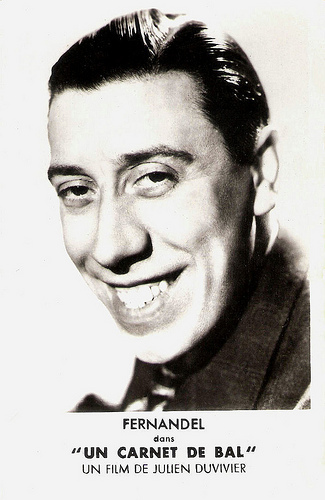
Fernandel . French postcard by Edition Chantal, Paris. Photo: publicity still for Un Carnet de Bal/Dance Program (Julien Duvivier, 1937).
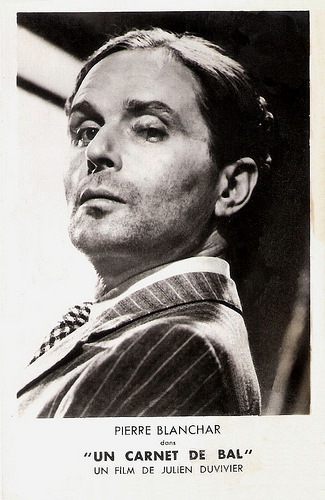
Pierre Blanchar . French postcard by Edition Chantal, Paris. Photo: publicity still for Un Carnet de Bal/Dance Program (Julien Duvivier, 1937).
Ruined lives, regrets, embittered human wrecks
Un carnet de bal was a box office success in France and the US. Modern reviewers have mixed opinions about the film.
James Travers at French Film Site : "Un carnet de bal is a good example of French cinema of the late 1930s, and one of the earliest successful attempts at the episodic film which became so popular in subsequent decades. The multi-part structure of the film (effectively a series of loosely connected vignettes) is a little unsatisfying, but the individual stories are themselves almost perfectly formed."
DB DuMonteil however is a a Duvivier fan and rates the film at IMDb with the maximum of 10 stars: "Leonard Maltin gives a four stars rating to this 1937 movie, and all we can do is approve of his judgment. The movie of nostalgia, of time passing by, of disenchantment, Un carnet de bal is all this and more."
In her search, Christine discovers ruined lives, regrets, embittered human wrecks. DB DuMonteil: "As always in Duvivier's work, the harder they fall, the better the sketches are. For it is basically a movie made up of sketches, Julien Duvivier's métier. All youth ideals have gone down the drain: the brilliant medicine student has become an abortionist; the lawyer with bright prospects now has a lousy shady cabaret; one of the woman's beaus is dead and his mother gone nuts acts as if he's still alive. Two of them have escaped to a doomed fate: but one has become a priest and the other keeps his love for something else than women."
At the 1937 Venice International Film Festival, Un carnet de bal won the award for best foreign film. In 1941, Duvivier remade his own film when he was in exile in Hollywood. In Lydia (Julien Duvivier, 1941) the title role was played by Merle Oberon , while Alan Marshall, Joseph Cotten and Hans Jaray played three of her former dance partners.
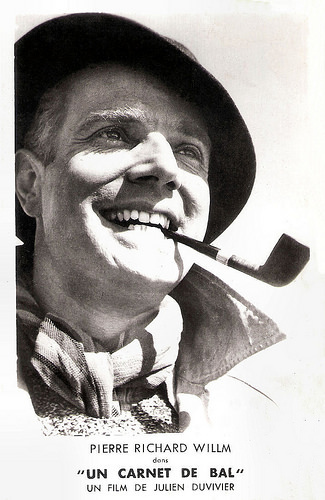
Pierre Richard Willm . French postcard by Edition Chantal, Paris. Photo: publicity still for Un Carnet de Bal/Dance Program (Julien Duvivier, 1937).
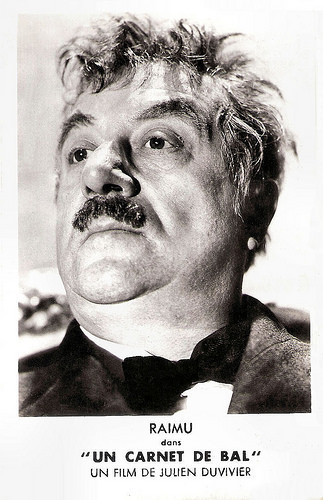
Raimu . French postcard by Edition Chantal, Paris. Photo: publicity still for Un Carnet de Bal/Dance Program (Julien Duvivier, 1937).
Sources: James Travers (French Film Site), DB DuMonteil (IMDb), Eduardo Casais (IMDb), Wikipedia (French) and IMDb.

Marie Bell . French postcard. Photo: collection Ciné Miroir.

Harry Baur . French postcard by Edition Chantal, Paris. Photo: publicity still for Un Carnet de Bal/Dance Program (Julien Duvivier, 1937).
A turning point in her life
Un Carnet de bal starts romantically on the banks of a fairy tale lake surrounded by mountains, where the still young and rich widow Christine Sugère ( Marie Bell - at the time 37) lives alone after the death of her husband.
She realizes she has possibly wasted her life by marrying the wrong man.
Just for the fun of it, she decides to find out about the men who danced with her during her first ball when she was 16. The ball was a turning point in her life
Following her old Dance Card (carnet de bal), Christine pays a visit to those forgotten dance partners, one by one. She is not only surprised to see how they have fared, but also discovers the impact she had, unknowingly, on the feelings and the destiny of these men.
The dream cast of Un carnet de bal includes such legendary names of the French cinema as Marie Bell , Fernandel , Harry Baur , Louis Jouvet - in one of his best roles, Pierre Blanchar , Raimu , Pierre Richard Willm , Francoise Rosay ... All of them at the peak of their form.
Julien Duvivier created a ‘portmanteau’ film with seven flashbacks, one prologue and a short epilogue. The parts are held together musically by Maurice Jaubert's haunting theme melody, the waltz Valse Grise. The postcards in this post show five of Christine's dance partners, who are all a subject for one of the segments.

Fernandel . French postcard by Edition Chantal, Paris. Photo: publicity still for Un Carnet de Bal/Dance Program (Julien Duvivier, 1937).

Pierre Blanchar . French postcard by Edition Chantal, Paris. Photo: publicity still for Un Carnet de Bal/Dance Program (Julien Duvivier, 1937).
Ruined lives, regrets, embittered human wrecks
Un carnet de bal was a box office success in France and the US. Modern reviewers have mixed opinions about the film.
James Travers at French Film Site : "Un carnet de bal is a good example of French cinema of the late 1930s, and one of the earliest successful attempts at the episodic film which became so popular in subsequent decades. The multi-part structure of the film (effectively a series of loosely connected vignettes) is a little unsatisfying, but the individual stories are themselves almost perfectly formed."
DB DuMonteil however is a a Duvivier fan and rates the film at IMDb with the maximum of 10 stars: "Leonard Maltin gives a four stars rating to this 1937 movie, and all we can do is approve of his judgment. The movie of nostalgia, of time passing by, of disenchantment, Un carnet de bal is all this and more."
In her search, Christine discovers ruined lives, regrets, embittered human wrecks. DB DuMonteil: "As always in Duvivier's work, the harder they fall, the better the sketches are. For it is basically a movie made up of sketches, Julien Duvivier's métier. All youth ideals have gone down the drain: the brilliant medicine student has become an abortionist; the lawyer with bright prospects now has a lousy shady cabaret; one of the woman's beaus is dead and his mother gone nuts acts as if he's still alive. Two of them have escaped to a doomed fate: but one has become a priest and the other keeps his love for something else than women."
At the 1937 Venice International Film Festival, Un carnet de bal won the award for best foreign film. In 1941, Duvivier remade his own film when he was in exile in Hollywood. In Lydia (Julien Duvivier, 1941) the title role was played by Merle Oberon , while Alan Marshall, Joseph Cotten and Hans Jaray played three of her former dance partners.

Pierre Richard Willm . French postcard by Edition Chantal, Paris. Photo: publicity still for Un Carnet de Bal/Dance Program (Julien Duvivier, 1937).

Raimu . French postcard by Edition Chantal, Paris. Photo: publicity still for Un Carnet de Bal/Dance Program (Julien Duvivier, 1937).
Sources: James Travers (French Film Site), DB DuMonteil (IMDb), Eduardo Casais (IMDb), Wikipedia (French) and IMDb.
Published on January 02, 2015 22:00
January 1, 2015
Gaby Deslys
French dancer and actress Gaby Deslys (1881-1920) was an internationally celebrated - and notorious - star of the early 20th Century. She was famous for her extravagant clothes, jewels and millinery. 'The Charm of Paris' had many admirers, most notably King Manuel II of Portugal. And before her tragic, early death she also made a series of silent films.
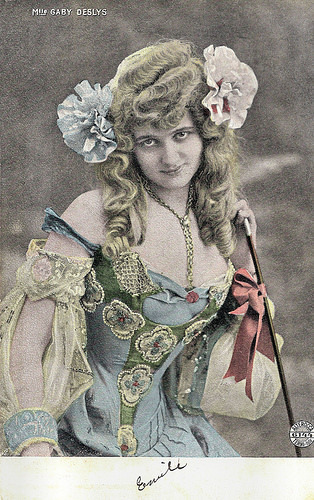
Italian postcard by Alterocca, Terni, no. 6144.
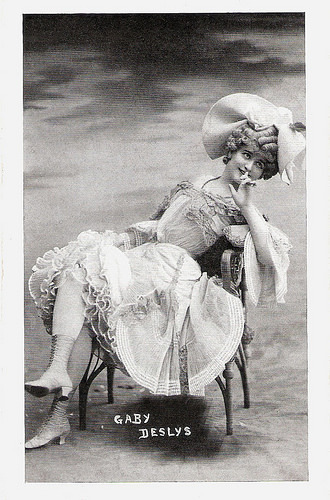
French postcard.
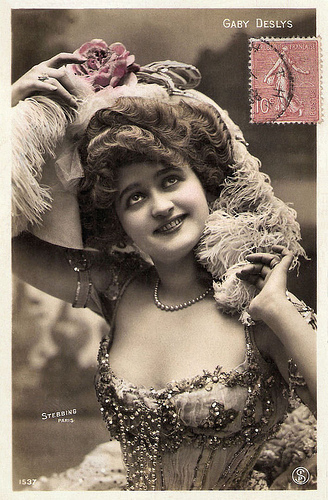
French postcard by SIP, no. 1537. Photo: Stebbing, Paris.
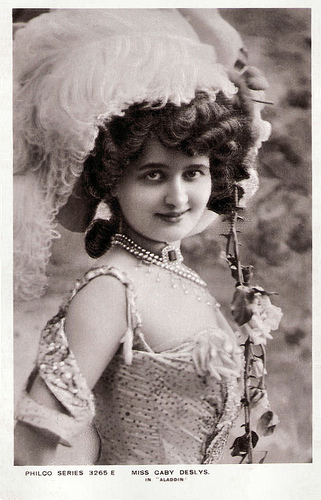
British postcard in the Philco Series, London, no. 3265 E. Photo: publicity still for The New Aladdin, produced at the Gaiety Theatre, London, in 1906. Gaby was 'The Charm of Paris'. The New Aladdin was produced by George Edwardes and ran for 203 performances.
The Ju-Jitsu Waltz
Gaby Deslys was born in the French harbour city Marseille as Marie-Elise Gabrielle Caire in 1881, but during the latter part of her life and after her death, this identification was put under scrutiny. (Wikipedia claims that she was Czech peasant girl, born in the village of Horní Moštěnice under the name of Hedvika Navratilova).
She selected the name Gaby Deslys for her stage career - an abbreviation of Gabrielle of the Lillies. She started her career in 1898 in the Folies Bergères in Paris. Gaby was dedicated to dancing, and loved to please the audiences.
In 1906 she travelled to London and appeared at the Gaiety Theatre in The New Aladdin and performed the Ju-Jitsu waltz. She was nicknamed 'The Charm of Paris'.
Deslys became an international celebrity following newspaper stories about King Manuel's infatuation with her. He is thought to have given Deslys a pearl necklace worth $70,000 after first meeting her in Paris in 1909. More gifts soon followed.
In 1911, she appeared on Broadway at the Winter Garden in Vera Violetta. In 1913 she starred in The Honeymoon Express which also featured Al Jolson (in blackface) and a young Mae West. Gaby’s costume gowns attained almost as much attention as she herself did. She is credited for introducing the first Striptease number in a Broadway Musical.
She returned to Paris with American dancer Henry (Harry) Pilcer, who she was rumoured to have been married to. Pilcer created her most famous dance, The Gaby Glide, which she performed in Europe and in the United States. They became the most popular dance couple of the music-halls of Paris.
With her ostrich feathers and sexy costumes, Gaby Deslys introduced a new style. She also introduced the first Jazzband to Paris: Alexander's Ragtime Band.
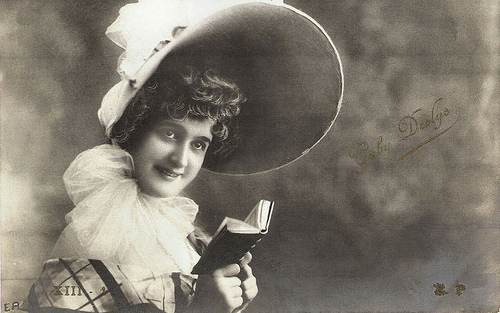
French postcard by E.P.
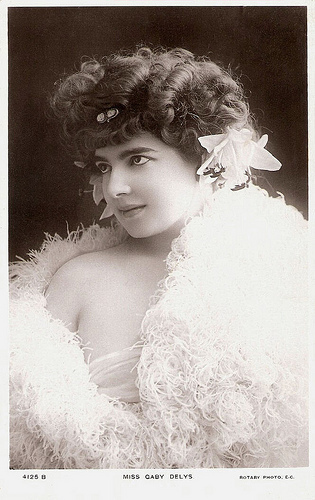
British postcard by Rotary Photo, no. 4125 B.
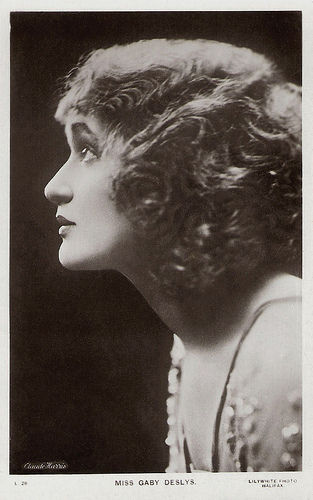
British postcard in the Lilywhite Photographic Series, Halifax, no. L 28. Photo: Claude Harris.
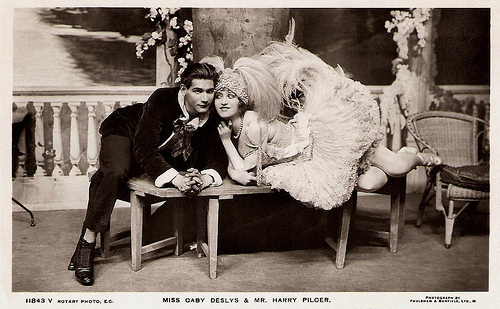
With Harry Pilcer. British postcard by Rotary Photo, no. 11843 V. Photo: Foulsham & Banfield.
Severe Throat Infection
In London Peter Pan author J.M. Barrie was so smitten by Gaby Deslys that he wrote a one-act play for her, Rosy Rapture, at the Duke of York's Theatre. This became also one of her first films, A Rosy Rapture (Percy Nash, 1914).
Deslys loved the camera and it loved her. From the beginning of her career she had posed for numerous still photographs. These stills, as with many other actresses, were sold as part of cigarette packages or after performance lobby cards aimed at patrons, usually male, who wanted a take home keepsake of their favourite performer.
Other short films followed like the French La Remplaçante/The Substitute (René Hervil, Louis Mercanton, 1914) with Jean Angelo . In 1915 Gaby Deslys and Harry Pilcer filmed for Famous Players Lasky in Paris Her Triumph (1915).
A feature film with the couple was Bouclette/Pincurl (René Hervil, Louis Mercanton, 1918), written by French avant-garde director Marcel L’Herbier who also co-starred.
In Dieu du hasard/God of the chance (Henri Pouctal, 1919) Gaby appeared with Félix Oudart, Georges Tréville and Harry Pilcer.
She graced the cover of Pictures and the Picturegoer magazine in 1915, and Erté did a serigraph painting of her.
On a number of occasions she appeared at the Grand Casino in Marseilles. Her final performance there was in 1919. Deslys contracted a severe throat infection caused by influenza. She was operated on multiple times in an effort to eradicate the infection, on two occasions without the use of an anaesthetic, but she died in Paris in February 1920 at the age of 38.
In her will she left her villa and all of her property, valued at half a million dollars, to the poor of Marseilles. Her carved and gilded bed, in the form of an enormous swan, was bought at an auction by the Universal Studios prop department, and was used in The Phantom of the Opera (1925) and in Sunset Boulevard (1950) as the bed of Norma Desmond.
Gaby Deslys was portrayed by Tamara Toumanova in Deep in My Heart (Stanley Donen, 1954).
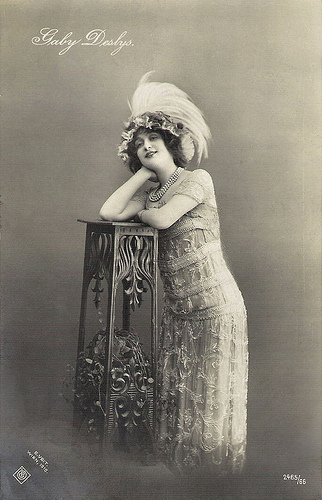
Austrian postcard by CP, no. 2465/66. Photo: E. Veit, Wien (Vienna), 1910.
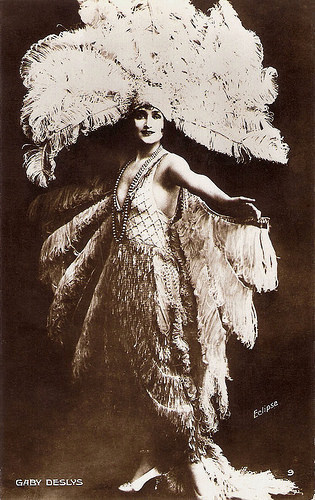
French postcard by Cinemagazine-Edition, no. 9. Photo: Eclipse.
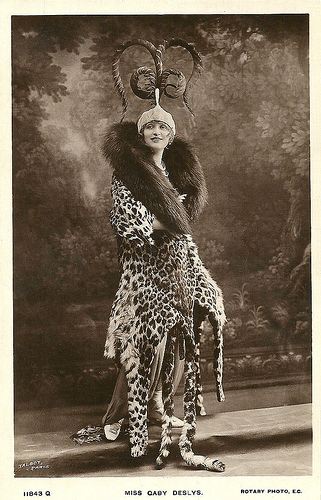
British postcard by Rotary Photo, no. 11843 Q. Photo: Talbot, Paris. Collection: Didier Hanson.
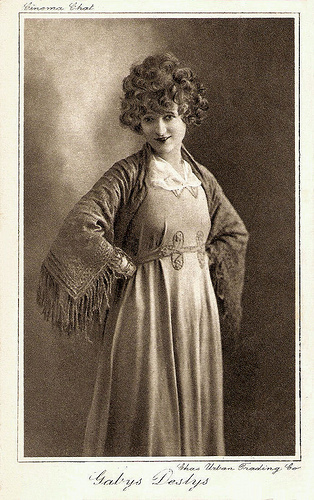
British postcard in the Cinema Chat series. Photo Chas Urban Trading co.
Sources: Wikipedia, Dance History Archives, National Portrait Gallery and .

Italian postcard by Alterocca, Terni, no. 6144.

French postcard.

French postcard by SIP, no. 1537. Photo: Stebbing, Paris.

British postcard in the Philco Series, London, no. 3265 E. Photo: publicity still for The New Aladdin, produced at the Gaiety Theatre, London, in 1906. Gaby was 'The Charm of Paris'. The New Aladdin was produced by George Edwardes and ran for 203 performances.
The Ju-Jitsu Waltz
Gaby Deslys was born in the French harbour city Marseille as Marie-Elise Gabrielle Caire in 1881, but during the latter part of her life and after her death, this identification was put under scrutiny. (Wikipedia claims that she was Czech peasant girl, born in the village of Horní Moštěnice under the name of Hedvika Navratilova).
She selected the name Gaby Deslys for her stage career - an abbreviation of Gabrielle of the Lillies. She started her career in 1898 in the Folies Bergères in Paris. Gaby was dedicated to dancing, and loved to please the audiences.
In 1906 she travelled to London and appeared at the Gaiety Theatre in The New Aladdin and performed the Ju-Jitsu waltz. She was nicknamed 'The Charm of Paris'.
Deslys became an international celebrity following newspaper stories about King Manuel's infatuation with her. He is thought to have given Deslys a pearl necklace worth $70,000 after first meeting her in Paris in 1909. More gifts soon followed.
In 1911, she appeared on Broadway at the Winter Garden in Vera Violetta. In 1913 she starred in The Honeymoon Express which also featured Al Jolson (in blackface) and a young Mae West. Gaby’s costume gowns attained almost as much attention as she herself did. She is credited for introducing the first Striptease number in a Broadway Musical.
She returned to Paris with American dancer Henry (Harry) Pilcer, who she was rumoured to have been married to. Pilcer created her most famous dance, The Gaby Glide, which she performed in Europe and in the United States. They became the most popular dance couple of the music-halls of Paris.
With her ostrich feathers and sexy costumes, Gaby Deslys introduced a new style. She also introduced the first Jazzband to Paris: Alexander's Ragtime Band.

French postcard by E.P.

British postcard by Rotary Photo, no. 4125 B.

British postcard in the Lilywhite Photographic Series, Halifax, no. L 28. Photo: Claude Harris.

With Harry Pilcer. British postcard by Rotary Photo, no. 11843 V. Photo: Foulsham & Banfield.
Severe Throat Infection
In London Peter Pan author J.M. Barrie was so smitten by Gaby Deslys that he wrote a one-act play for her, Rosy Rapture, at the Duke of York's Theatre. This became also one of her first films, A Rosy Rapture (Percy Nash, 1914).
Deslys loved the camera and it loved her. From the beginning of her career she had posed for numerous still photographs. These stills, as with many other actresses, were sold as part of cigarette packages or after performance lobby cards aimed at patrons, usually male, who wanted a take home keepsake of their favourite performer.
Other short films followed like the French La Remplaçante/The Substitute (René Hervil, Louis Mercanton, 1914) with Jean Angelo . In 1915 Gaby Deslys and Harry Pilcer filmed for Famous Players Lasky in Paris Her Triumph (1915).
A feature film with the couple was Bouclette/Pincurl (René Hervil, Louis Mercanton, 1918), written by French avant-garde director Marcel L’Herbier who also co-starred.
In Dieu du hasard/God of the chance (Henri Pouctal, 1919) Gaby appeared with Félix Oudart, Georges Tréville and Harry Pilcer.
She graced the cover of Pictures and the Picturegoer magazine in 1915, and Erté did a serigraph painting of her.
On a number of occasions she appeared at the Grand Casino in Marseilles. Her final performance there was in 1919. Deslys contracted a severe throat infection caused by influenza. She was operated on multiple times in an effort to eradicate the infection, on two occasions without the use of an anaesthetic, but she died in Paris in February 1920 at the age of 38.
In her will she left her villa and all of her property, valued at half a million dollars, to the poor of Marseilles. Her carved and gilded bed, in the form of an enormous swan, was bought at an auction by the Universal Studios prop department, and was used in The Phantom of the Opera (1925) and in Sunset Boulevard (1950) as the bed of Norma Desmond.
Gaby Deslys was portrayed by Tamara Toumanova in Deep in My Heart (Stanley Donen, 1954).

Austrian postcard by CP, no. 2465/66. Photo: E. Veit, Wien (Vienna), 1910.

French postcard by Cinemagazine-Edition, no. 9. Photo: Eclipse.

British postcard by Rotary Photo, no. 11843 Q. Photo: Talbot, Paris. Collection: Didier Hanson.

British postcard in the Cinema Chat series. Photo Chas Urban Trading co.
Sources: Wikipedia, Dance History Archives, National Portrait Gallery and .
Published on January 01, 2015 22:00
December 31, 2014
Roberto Benigni
Happy New Year! We start 2015 with Italy’s most popular film comedian since Totó, Roberto Benigni (1952). He worked with famous directors like Jim Jarmusch, Marco Ferreri, Bernardo Bertolucci, Federico Fellini, Wim Wenders, and Woody Allen. Benigni also directed several comedies himself, including the award winning La vita è bella/Life Is Beautiful (1997).
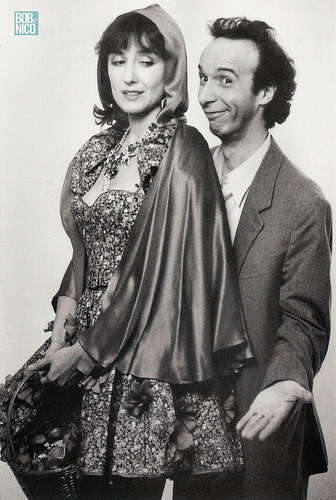
Italian postcard by Cineteca Bologna. Photo: Mimmo Cattarinich. Publicity still for Il Mostro/The Monster (Roberto Benigni, 1994) with Nicoletta Braschi.
Altar Boy
Roberto Remigio Benigni was born in Manciano La Misericordia, Italy, 1952 His parents were Luigi Benigni and Isolina Papini and he has three sisters. His father worked as a farmer, carpenter and bricklayer. He was a prisoner in the concentration camp Bergen-Belsen between 1943 and 1945. Roberto used his stories as the basis for his film La vita è bella (1997). His mother worked as a fabric inspector. Roberto was raised Catholic, served as an altar boy and attended a seminary in Florence, planning to become a priest.
In 1971, he moved to Rome where he took part in some experimental theatre shows, some of which he also directed. In 1975, Benigni had his first theatrical success with the play Cioni Mario di Gaspare fu Giulia (1975), written and directed by Giuseppe Bertolucci. Benigni played Mario Cioni, a character he later resumed in the variety TV series Onda Libera (Renzo Arbore, 1976). Benigni became famous in Italy when he interpreted in Onda Libera the satirical song L'inno del corpo sciolto (The Hymn of the Slippery Body), about the joys of defecation. It caused such a scandal that the censors suspended the series.
Benigni played Mario Cioni again in his first film, the comedy Berlinguer ti voglio bene/Berlinguer, I Love You (Giuseppe Bertolucci, 1977) with Alida Valli as his mother. The title quotes Benigni´s character´s declaration of love for Enrico Berlinguer, then leader of the Italian Communist Party. Later, Benigni appeared during a public political demonstration by the Italian Communist Party. On this occasion he lifted and cradled Berlinguer, normally a very serious figure. It was an unprecedented but very successful act, which lead politicians to exhibit a more popular behaviour from that moment on.
His popularity increased with L'altra domenica (1976-1979), another TV show in which Benigni portrays a lazy film critic who never watches the films he's asked to review. In 1979 he had an international success with the symbolic social drama Chiedo asilo/Seeking Asylum (Marco Ferreri, 1979) about a well-meaning teacher and his young pre-school class. The film was entered into the 30th Berlin International Film Festival where it won the Silver Bear - Special Jury Prize. Bernardo Bertolucci cast him in a small speechless role as a window upholsterer in La Luna/Luna (1979) starring Jill Clayburgh.
In 1980 Benigni met actress Nicoletta Braschi, who in 1991 became his wife. She co-starred in his first film as director, the comedy Tu mi turbi/You Upset Me (Roberto Benigni, 1983) and in most of his later films. Next, he played with the popular comic actor Massimo Troisi in Non ci resta che piangere/Nothing Left To Do But Cry (Roberto Benigni, Massimo Troisi, 1984). In this fable the two protagonists are suddenly thrown back in time to the 15th century, just a little before 1492. They start looking for Christopher Columbus in order to stop him from discovering the Americas (for very personal love reasons), but are not able to reach him.

Italian postcard by Cineteca Bologna. Photo: Mario Tursi. Publicity still for Il piccolo diavolo/The Little Devil (Roberto Benigni, 1988) with Nicoletta Braschi.
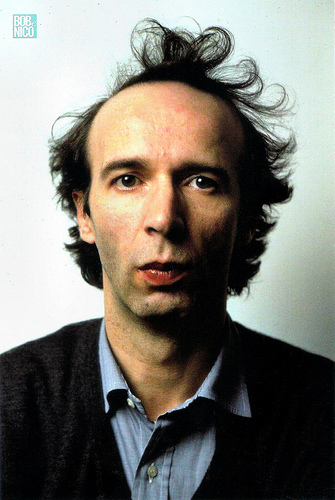
Italian postcard by Cineteca Bologna. Photo: Mimmo Catarinich.
Irrepressible good humour
Roberto Benigni was censored again in the 1980s for calling Pope John Paul II ‘Wojtylaccio’ during a TV show (‘Wojtylaccio’, translates as ‘Bad Wojtyla’, but with a friendly meaning in Tuscan dialect).
Benigni starred in three films by American director Jim Jarmusch. In Down By Law (Jim Jarmusch, 1986) he played Bob, an innocent foreigner living in the United States, convicted of manslaughter, whose irrepressible good humour and optimism help him to escape and find love. His co-stars were Tom Waits, John Lurie and Nicoletta Braschi, who of course played his beloved.
In Night on Earth (Jim Jarmusch, 1991) he played a cabbie in Rome, who causes his passenger, a priest (Paolo Bonacelli), great discomfort and a fatal heart attack by confessing his bizarre sexual experiences. He also starred in the first of Jarmusch's segments in Coffee and Cigarettes (2003).
In 1988 Benigni began a long-lasting collaboration with screenwriter Vincenzo Cerami. Their first film was Il piccolo diavolo/The Little Devil (Roberto Benigni, 1988) with Walter Matthau. For his part as the little devil, Benigni won the David di Donatello Award for Best Actor. It was the start of a series of comedies that were very popular in Italy, including Johnny Stecchino/Johnny Toothpick (Roberto Benigni, 1992), and Il mostro/The Monster (Roberto Benigni, Yves Attal, 1994). The box-office hit Johnny Stecchino, brought him considerable international attention.
Benigni had a rare serious role in Fellini's last film, La voce della luna/The Voice of the Moon (Federico Fellini, 1989). He also starred in Wim Wenders' Faraway, So Close (1993) and Son of the Pink Panther (Blake Edwards, 1993) as Inspector Clouseau's (Peter Sellers) illegitimate son who is assigned to save the Princess of Lugash. Also in this film are Panther regulars Herbert Lom , Burt Kwouk and a star of the original 1963 film, Claudia Cardinale . The film bombed in the US, but was a hit in Italy.
Outside his homeland, Benigni is probably best known for his tragicomedy La vita è bella/Life Is Beautiful (Roberto Benigni, 1997), also written by Vincenzo Cerami. The film is about an Italian Jewish man who tries to protect his son's innocence during his internment at a Nazi concentration camp, by telling him that the Holocaust is an elaborate game and he must adhere very carefully to the rules to win.
Benigni's father had spent three years in a concentration camp in Bergen-Belsen, and La vita è bella is based in part on his father's experiences. Although the story and presentation of the film had been discussed during production with different Jewish groups to limit the offense it might cause, critics accused the film of presenting the Holocaust without much suffering.
La vita è bella was shown at the 1998 Cannes Film Festival, and won the Grand Prix. In 1999 Benigni also won the Oscar for Best Actor. The score by Nicola Piovani won another Oscar for Best Original Dramatic Score, and the film was awarded the Oscar for Best Foreign Language Film. Famously, Benigni climbed over and then stood on the backs of the seats in front of him and applauded the audience before proceeding to the stage. And after winning his Best Actor Oscar, he said in his acceptance speech, "This is a terrible mistake because I used up all my English!" The film grossed worldwide more than $200 million.
He then appeared in the live-action film Astérix & Obélix contre César/Asterix and Obelix vs Caesar (Claude Zidi, 1999), based on Goscinny and Uderzo's Astérix comics and featuring Christian Clavier as Asterix and Gérard Depardieu as Obélix. Benigni played Lucius Detritus, a corrupt Roman provincial governor who wants to kill Julius Caesar.
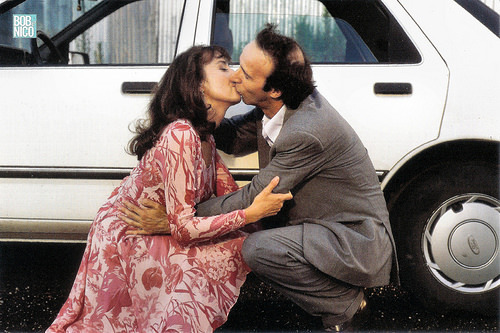
Italian postcard by Cineteca Bologna. Photo: Mimmo Cattarinich. Publicity still for Il Mostro/The Monster (Roberto Benigni, 1994) with Nicoletta Braschi.
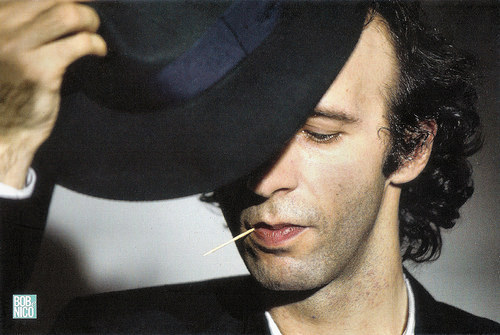
Italian postcard by Cineteca Bologna. Photo: Mimmo Catarinich.
Donatello and Raspberry Awards
Roberto Benigni’s next film, the live-action Pinocchio (Roberto Benigni, 2002) was one of the costliest films in Italian cinema ever. It performed well in Italy, but it bombed in North America. Pinocchio received six nominations at the David di Donatello Awards, winning two, as well as winning one of the two awards it was nominated for at the Italian National Syndicate of Film Journalists. At the 23rd Golden Raspberry Awards however, Benigni was named as the Worst Actor for his role as Pinocchio.
Benigni gave a typically energetic and revealing interview for Fellini: I'm a Born Liar (Damian Pettigrew, 2002), a cinematic portrait of the maestro that was nominated for Best Documentary at the European Film Awards.
His next film was La tigre e la neve/The Tiger and the Snow (Roberto Benigni, 2005) a romantic comedy set in contemporary Rome and in occupied Baghdad during the Iraq War.
In 2006 and 2007, Benigni toured Italy with his 90-minute one man show TuttoDante (Everything About Dante). Combining current events and memories of his past narrated with an ironic tone, Benigni then begins a journey of poetry and passion through the world of the Divine Comedy.
He performed TuttoDante during 130 shows in Italian piazzas, arenas, and stadiums for about one million spectators. Over 10 million more spectators watched the TV show, Il V canto dell’Inferno/The 5th Song of Hell (2007). In 2008-2009, Benigni brought TuttoDante to the United States and Canada.
His latest film appearance was in a segment of To Rome with Love (Woody Allen, 2012). Benigni played a man who wakes up one morning to discover that he has inexplicably become a national celebrity. To Rome with Love received mixed reviews but was a box office success.
Italian trailer for Il piccolo diavolo/The Little Devil (1988). Source: DionysusCinema (YouTube).
Trailer Il mostro/The Monster (1994). Source: GiuseppeDF (YouTube).
Italian trailer for Pinocchio (2002). Source: Gruppo Primavisione (YouTube).
Sources: Hal Erickson (AllMovie), Wikipedia and .

Italian postcard by Cineteca Bologna. Photo: Mimmo Cattarinich. Publicity still for Il Mostro/The Monster (Roberto Benigni, 1994) with Nicoletta Braschi.
Altar Boy
Roberto Remigio Benigni was born in Manciano La Misericordia, Italy, 1952 His parents were Luigi Benigni and Isolina Papini and he has three sisters. His father worked as a farmer, carpenter and bricklayer. He was a prisoner in the concentration camp Bergen-Belsen between 1943 and 1945. Roberto used his stories as the basis for his film La vita è bella (1997). His mother worked as a fabric inspector. Roberto was raised Catholic, served as an altar boy and attended a seminary in Florence, planning to become a priest.
In 1971, he moved to Rome where he took part in some experimental theatre shows, some of which he also directed. In 1975, Benigni had his first theatrical success with the play Cioni Mario di Gaspare fu Giulia (1975), written and directed by Giuseppe Bertolucci. Benigni played Mario Cioni, a character he later resumed in the variety TV series Onda Libera (Renzo Arbore, 1976). Benigni became famous in Italy when he interpreted in Onda Libera the satirical song L'inno del corpo sciolto (The Hymn of the Slippery Body), about the joys of defecation. It caused such a scandal that the censors suspended the series.
Benigni played Mario Cioni again in his first film, the comedy Berlinguer ti voglio bene/Berlinguer, I Love You (Giuseppe Bertolucci, 1977) with Alida Valli as his mother. The title quotes Benigni´s character´s declaration of love for Enrico Berlinguer, then leader of the Italian Communist Party. Later, Benigni appeared during a public political demonstration by the Italian Communist Party. On this occasion he lifted and cradled Berlinguer, normally a very serious figure. It was an unprecedented but very successful act, which lead politicians to exhibit a more popular behaviour from that moment on.
His popularity increased with L'altra domenica (1976-1979), another TV show in which Benigni portrays a lazy film critic who never watches the films he's asked to review. In 1979 he had an international success with the symbolic social drama Chiedo asilo/Seeking Asylum (Marco Ferreri, 1979) about a well-meaning teacher and his young pre-school class. The film was entered into the 30th Berlin International Film Festival where it won the Silver Bear - Special Jury Prize. Bernardo Bertolucci cast him in a small speechless role as a window upholsterer in La Luna/Luna (1979) starring Jill Clayburgh.
In 1980 Benigni met actress Nicoletta Braschi, who in 1991 became his wife. She co-starred in his first film as director, the comedy Tu mi turbi/You Upset Me (Roberto Benigni, 1983) and in most of his later films. Next, he played with the popular comic actor Massimo Troisi in Non ci resta che piangere/Nothing Left To Do But Cry (Roberto Benigni, Massimo Troisi, 1984). In this fable the two protagonists are suddenly thrown back in time to the 15th century, just a little before 1492. They start looking for Christopher Columbus in order to stop him from discovering the Americas (for very personal love reasons), but are not able to reach him.

Italian postcard by Cineteca Bologna. Photo: Mario Tursi. Publicity still for Il piccolo diavolo/The Little Devil (Roberto Benigni, 1988) with Nicoletta Braschi.

Italian postcard by Cineteca Bologna. Photo: Mimmo Catarinich.
Irrepressible good humour
Roberto Benigni was censored again in the 1980s for calling Pope John Paul II ‘Wojtylaccio’ during a TV show (‘Wojtylaccio’, translates as ‘Bad Wojtyla’, but with a friendly meaning in Tuscan dialect).
Benigni starred in three films by American director Jim Jarmusch. In Down By Law (Jim Jarmusch, 1986) he played Bob, an innocent foreigner living in the United States, convicted of manslaughter, whose irrepressible good humour and optimism help him to escape and find love. His co-stars were Tom Waits, John Lurie and Nicoletta Braschi, who of course played his beloved.
In Night on Earth (Jim Jarmusch, 1991) he played a cabbie in Rome, who causes his passenger, a priest (Paolo Bonacelli), great discomfort and a fatal heart attack by confessing his bizarre sexual experiences. He also starred in the first of Jarmusch's segments in Coffee and Cigarettes (2003).
In 1988 Benigni began a long-lasting collaboration with screenwriter Vincenzo Cerami. Their first film was Il piccolo diavolo/The Little Devil (Roberto Benigni, 1988) with Walter Matthau. For his part as the little devil, Benigni won the David di Donatello Award for Best Actor. It was the start of a series of comedies that were very popular in Italy, including Johnny Stecchino/Johnny Toothpick (Roberto Benigni, 1992), and Il mostro/The Monster (Roberto Benigni, Yves Attal, 1994). The box-office hit Johnny Stecchino, brought him considerable international attention.
Benigni had a rare serious role in Fellini's last film, La voce della luna/The Voice of the Moon (Federico Fellini, 1989). He also starred in Wim Wenders' Faraway, So Close (1993) and Son of the Pink Panther (Blake Edwards, 1993) as Inspector Clouseau's (Peter Sellers) illegitimate son who is assigned to save the Princess of Lugash. Also in this film are Panther regulars Herbert Lom , Burt Kwouk and a star of the original 1963 film, Claudia Cardinale . The film bombed in the US, but was a hit in Italy.
Outside his homeland, Benigni is probably best known for his tragicomedy La vita è bella/Life Is Beautiful (Roberto Benigni, 1997), also written by Vincenzo Cerami. The film is about an Italian Jewish man who tries to protect his son's innocence during his internment at a Nazi concentration camp, by telling him that the Holocaust is an elaborate game and he must adhere very carefully to the rules to win.
Benigni's father had spent three years in a concentration camp in Bergen-Belsen, and La vita è bella is based in part on his father's experiences. Although the story and presentation of the film had been discussed during production with different Jewish groups to limit the offense it might cause, critics accused the film of presenting the Holocaust without much suffering.
La vita è bella was shown at the 1998 Cannes Film Festival, and won the Grand Prix. In 1999 Benigni also won the Oscar for Best Actor. The score by Nicola Piovani won another Oscar for Best Original Dramatic Score, and the film was awarded the Oscar for Best Foreign Language Film. Famously, Benigni climbed over and then stood on the backs of the seats in front of him and applauded the audience before proceeding to the stage. And after winning his Best Actor Oscar, he said in his acceptance speech, "This is a terrible mistake because I used up all my English!" The film grossed worldwide more than $200 million.
He then appeared in the live-action film Astérix & Obélix contre César/Asterix and Obelix vs Caesar (Claude Zidi, 1999), based on Goscinny and Uderzo's Astérix comics and featuring Christian Clavier as Asterix and Gérard Depardieu as Obélix. Benigni played Lucius Detritus, a corrupt Roman provincial governor who wants to kill Julius Caesar.

Italian postcard by Cineteca Bologna. Photo: Mimmo Cattarinich. Publicity still for Il Mostro/The Monster (Roberto Benigni, 1994) with Nicoletta Braschi.

Italian postcard by Cineteca Bologna. Photo: Mimmo Catarinich.
Donatello and Raspberry Awards
Roberto Benigni’s next film, the live-action Pinocchio (Roberto Benigni, 2002) was one of the costliest films in Italian cinema ever. It performed well in Italy, but it bombed in North America. Pinocchio received six nominations at the David di Donatello Awards, winning two, as well as winning one of the two awards it was nominated for at the Italian National Syndicate of Film Journalists. At the 23rd Golden Raspberry Awards however, Benigni was named as the Worst Actor for his role as Pinocchio.
Benigni gave a typically energetic and revealing interview for Fellini: I'm a Born Liar (Damian Pettigrew, 2002), a cinematic portrait of the maestro that was nominated for Best Documentary at the European Film Awards.
His next film was La tigre e la neve/The Tiger and the Snow (Roberto Benigni, 2005) a romantic comedy set in contemporary Rome and in occupied Baghdad during the Iraq War.
In 2006 and 2007, Benigni toured Italy with his 90-minute one man show TuttoDante (Everything About Dante). Combining current events and memories of his past narrated with an ironic tone, Benigni then begins a journey of poetry and passion through the world of the Divine Comedy.
He performed TuttoDante during 130 shows in Italian piazzas, arenas, and stadiums for about one million spectators. Over 10 million more spectators watched the TV show, Il V canto dell’Inferno/The 5th Song of Hell (2007). In 2008-2009, Benigni brought TuttoDante to the United States and Canada.
His latest film appearance was in a segment of To Rome with Love (Woody Allen, 2012). Benigni played a man who wakes up one morning to discover that he has inexplicably become a national celebrity. To Rome with Love received mixed reviews but was a box office success.
Italian trailer for Il piccolo diavolo/The Little Devil (1988). Source: DionysusCinema (YouTube).
Trailer Il mostro/The Monster (1994). Source: GiuseppeDF (YouTube).
Italian trailer for Pinocchio (2002). Source: Gruppo Primavisione (YouTube).
Sources: Hal Erickson (AllMovie), Wikipedia and .
Published on December 31, 2014 22:00
December 30, 2014
Liselotte Pulver
Swiss actress Liselotte Pulver (1929) was one of the most beloved stars of the German popular cinema of the 1950s and early 1960s. Despite a wide variety of roles, she is best remembered as the merry tomboy in sparkling comedies like Das Wirtshaus im Spessart/The Spessart Inn (1958).
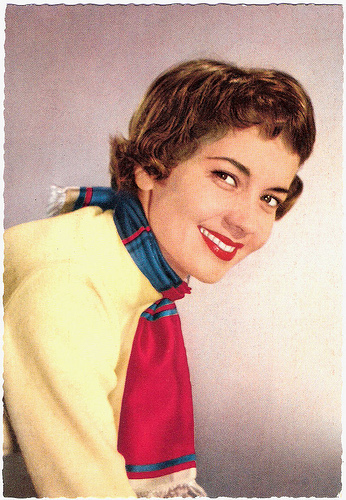
German postcard by ISV, no. E 16. Photo: Witt-Film / Constantin / Bokelberg.
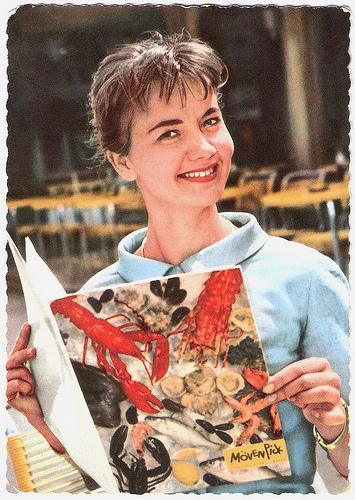
German postcard by UFA, no. CK-237. Retail price: 30 Pfg. Photo: Joe Niczky / Ufa. Collection: Egbert Barten.
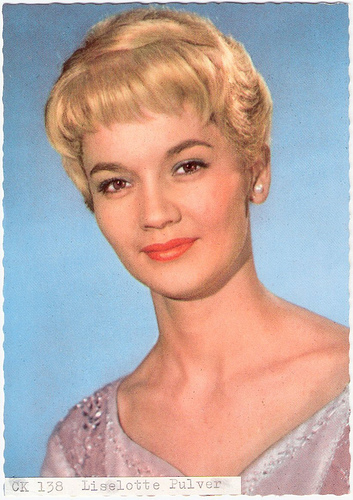
German postcard by Universum-Film Aktiengesellschaft (UFA), Berlin-Tempelhof, no. CK-138. Photo: Ringpress / Vogelmann.
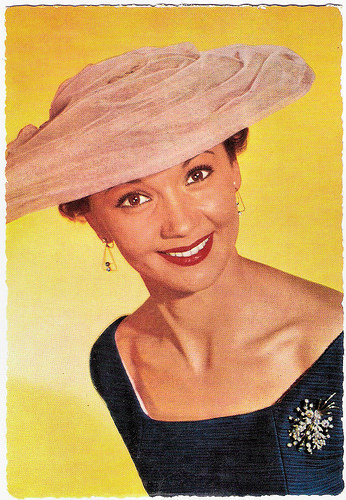
German postcard by WS-Druck, Wanne-Eickel, no. F. 15. Photo: Ringpress.

German postcard by WS-Druck, Wanne-Eickel, no. F 42. Photo: Collignon.
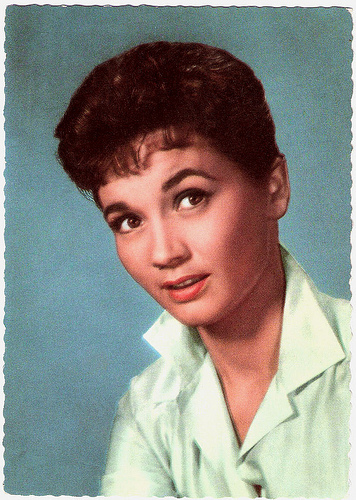
German postcard by Ufa, Berlin-Tempelhof, no. CK 166. Retail price: 30 Pfg. Photo: Universal-Film Inc.
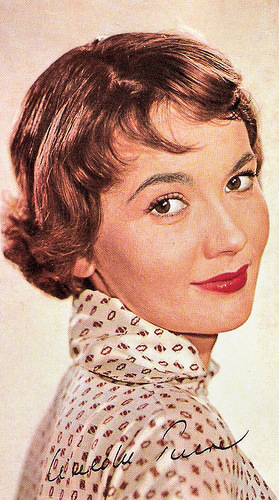
German collectors card by Lux.
First Box Office Hits
Liselotte (nicknamed Lilo) Pulver was born in Bern, Switzerland, in 1929. She was the youngest daughter of civil engineer Fritz Eugen Pulver and his wife Germaine. Her older sister was journalist Corinne Pulver.
From 1945 on Liselotte attended commercial school. After graduating in 1948, she started to work as a mannequin and took acting classes at the Berner Konservatorium (Bern conservatory). She made her stage debut at the Stadttheater Bern (Bern Theatre), and from 1949 to 1951 she appeared at the renowned Schauspielhaus Zurich.
Austrian film director Leopold Lindtberg cast the 20-year-old actress in his Swiss-American comedy Swiss Tour/Four Days Leave (Leopold Lindtberg, 1950) starring Cornel Wilde. After this debut, she inaugurated a long career in European films.
She first starred alongside Hans Albers in the mountain drama Föhn/White Hell (Rolf Hansen, 1950). Then she worked for the first time with director Kurt Hoffmann on the crime comedy Klettermaxe (1952). They would make 10 films together.
Her first box office hits were the Swiss film Uli der Knecht/Uli the Servant (Franz Schnyder, 1954) and its sequel Uli der Pächter/Uli the Tenant (Franz Schnyder, 1955).
Her breakthrough role was a Puszta school girl in Ich denke oft an Piroschka/I Often Think of Piroschka (Kurt Hoffmann, 1955). This Heimatfilm was not situated in Germany but in the Hungarian provinces, known as the Puszta. By focusing on the cultural differences between a German student on holidays and his Hungarian hosts as well as the student's unfamiliarity with rural life, Hoffmann created a sparkling comedy. Stephanie D'heil at Steffi-line writes that it made Pulver the German equivalent of Audrey Hepburn .
Another big hit was the fairy tale Das Wirtshaus im Spessart/The Spessart Inn (Kurt Hoffmann, 1958), in which she played a lovely countess who dresses up as a man to join a gang of robbers. The huge success of this film made her the prototype tomboy of the German cinema of the 1950s, with her hearty and joyful laughter as her trademark. Das Wirtshaus im Spessart inspired two sequels in 1960 and 1967, both directed by Hoffmann and starring Pulver.
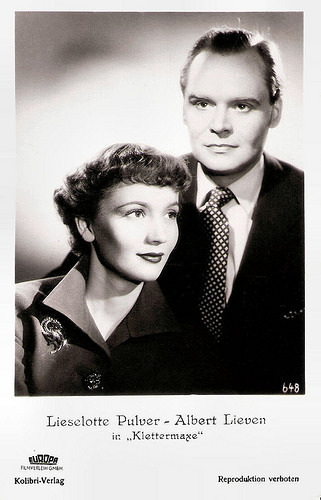
German postcard by Kolibri-Verlag, no. 648. Photo: Europa Filmverleih. Publicity still for Klettermaxe/Corry Bell (Kurt Hoffmann, 1952) with Albert Lieven .
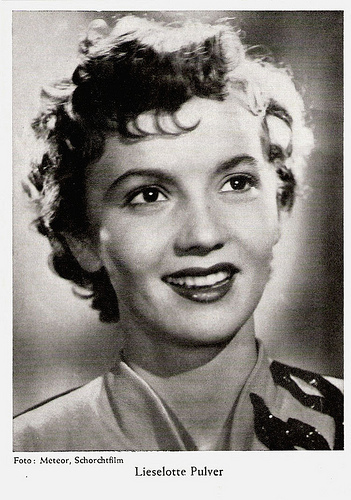
Belgian card. Photo: Meteor / Schorchtfilm.
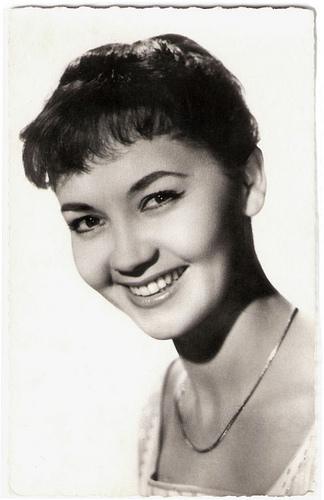
French postcard by Edition du Globe, Paris, no. 712. Photo: Sam Lévin.
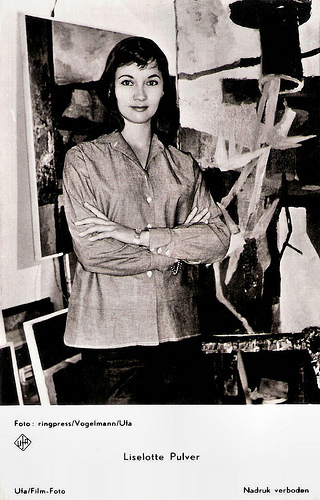
Dutch postcard by Gebr. Spanjersberg NV, Rotterdam, no. 4527. Photo: Ringpress / Vogelmann / Ufa.
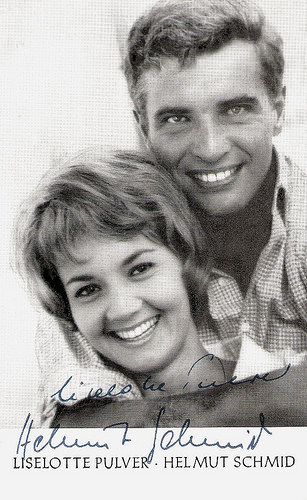
With husband Helmut Schmid. German postcard by Eduard Huber Verlag, Grünwald.
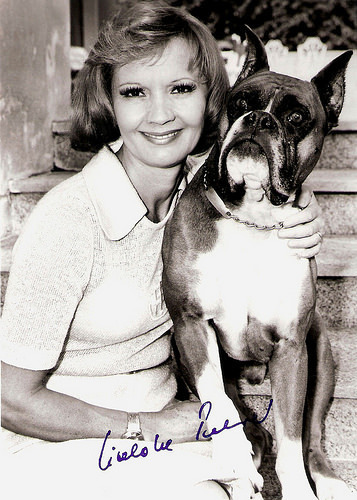
Swiss postcard by Linda Color, Genève. Photo: Erwin Schneider.
International Fame
Quickly Liselotte Pulver rose to international fame. She starred in the French crime film Les aventures d’Arsène Lupin/The Adventures of Arsène Lupin (Jacques Becker, 1957), as well as in the American Erich Maria Remarque adaptation A Time to Love and a Time to Die (Douglas Sirk, 1958).
Alongside French idol Gérard Philipe she starred in Le joueur/The Gambler (Claude Autant-Lara, 1958), an adaptation of Fyodor Dostoyevky's novel. She was considered to play leading roles in the Hollywood epics Ben-Hur (1959) and El Cid (1961), but she had already signed for other projects in Germany. She later said that this had been the biggest disappointment in her career.
In Germany, she starred in Die Zürcher Verlobung/The Affairs of Julie (Helmut Käutner, 1957), Das Glas Wasser/A Glass of Water (Helmut Käutner, 1960), and the Thomas Mann adaptations Bekenntnisse des Hochstaplers Felix Krull/Confessions of Felix Krull (Kurt Hoffmann, 1957) and Buddenbrooks (Alfred Weidenmann, 1959).
She proved her talent for slapstick in the comedy One, Two, Three (Billy Wilder, 1961). As busty, blonde Fraulein Ingeborg, the gum chewing secretary of philandering Coca-Cola executive James Cagney she was hilarious. For her role as a Russian woman in the Bob Hope comedy A Global Affair (Jack Arnold, 1963) she was nominated for the Golden Globe Award as best supporting actress. Artistically, her performance as a lesbian abbess in La Religieuse/The Nun (Jacques Rivette, 1966) became the highlight of her career.
In 1960, she had met Swiss actor Helmut Schmid on the set of Gustav Adolfs Page (Rolf Hansen, 1960), and they married the following year. The couple had two children, son Marc-Tell (1962) and daughter Melisande (1967).
More and more she focussed on television and she appeared in several TV-series. From 1977 to 1983, she co-hosted Sesamstrasse, the German version of Sesame Street. In 1980, she won the Filmband in Gold for her longtime achievements in the German cinema. Furthermore, she published her memories … wenn man trotzdem lacht (If one laughs nevertheless) (1990). There were some tragedies in her private life. Her daughter Melisande committed suicide in 1989, and her husband, Helmut Schmid, died in 1992 of a heart attack.
Her last film was the hit comedy Das Superweib/The Superwife (Sönke Wortmann, 1996) with Heiner Lauterbach. On TV she was last seen in a remake of her film Die Zürcher Verlobung/The Affairs of Julie (Stephan Meyer, 2007) with Christoph Waltz.
Nowadays Liselotte Pulver lives secluded in her mansion in Perroy, on the shores of Lake Geneva. She also has an apartment at the Burgerheim, a retirement home near Bern.
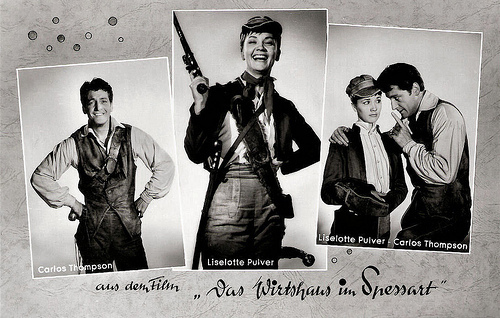
German postcard by Franz Josef Rüdel, Filmpostkartenverlag, Hamburg-Bergedorf, no. 2374. Photo: Witt / Constantin / Ringpress / Vogelmann. Publicity card for Das Wirtshaus im Spessart/The Spessart Inn (1958) with Carlos Thompson .
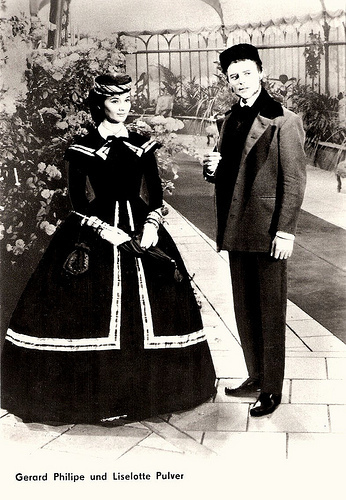
East-German postcard by VEB Progress Film-Vertrieb, no. 2699. Retail price: 0,20 MDN. Photo: publicity still for Le joueur/The Gambler (Claude Autant-Lara, 1958) with Gérard Philipe .
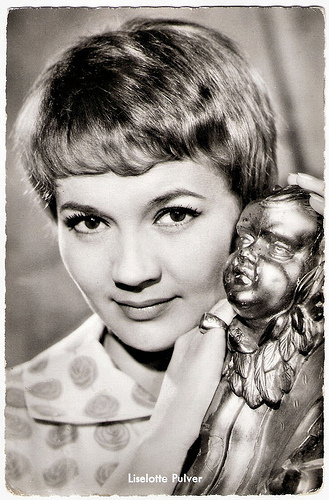
German postcard by Kolibri-Verlag G.m.b.H., Minden-Westf., no. 1389. Photo: Witt / Constantin / Grimm. Publicity still for Das Spukschloss im Spessart/The Haunted Caste (Kurt Hoffmann, 1960).

East-German postcard by VEB Progress Filmvertrieb, no. 1547, 1961. Photo: publicity still for Das Spukschloss im Spessart/The Haunted Castle (Kurt Hoffmann, 1960) with Georg Thomalla and Curt Bois.
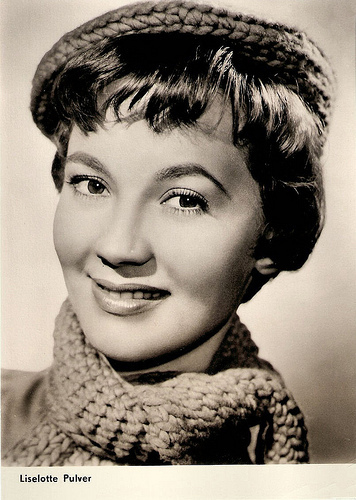
East-German postcard by VEB Progress Film-Vertrieb, Berlin, no. 2151, 1964. Retail price: 0,20 DM. Photo: Progress.
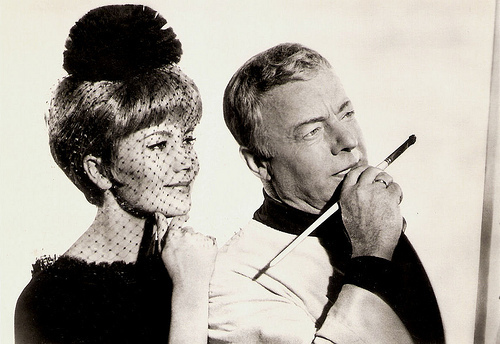
East-German postcard by VEB Progress Film-Vertrieb, Berlin, no. 2662, 1966. Retail price: 0,20 DM. Photo: Progress. Publicity still for Hokuspokus oder: Wie lasse ich meinen Mann verschwinden...?/Hocuspocus (Kurt Hoffmann, 1966) with Heinz Rühmann .
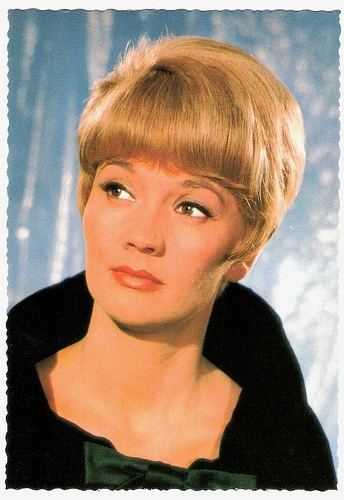
German postcard by ISV, no. E 37. Photo: Constantin. Publicity still for Hokuspokus oder: Wie lasse ich meinen Mann verschwinden...?/Hocuspocus (Kurt Hoffmann, 1966).
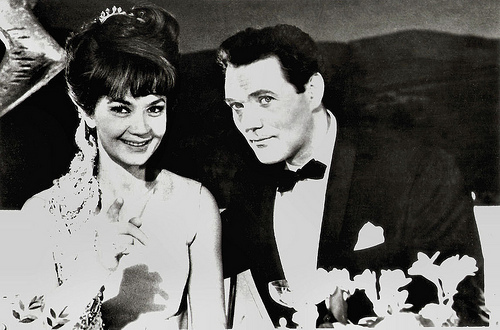
Romanian postcard by Casa Filmului Acin, no. 368. Photo: publicity still for Herrliche Zeiten im Spessart/Glorious Times in the Spessart (Kurt Hoffmann, 1967) with Harald Leipnitz.
Scene from Das Wirtshaus im Spessart/The Spessart Inn (1958). Source: Klarinettenqueen (YouTube).
Sources: Stephanie D'heil (Steffi-line) (German), Hal Erickson (AllMovie), Filmportal.de, Wikipedia and .

German postcard by ISV, no. E 16. Photo: Witt-Film / Constantin / Bokelberg.

German postcard by UFA, no. CK-237. Retail price: 30 Pfg. Photo: Joe Niczky / Ufa. Collection: Egbert Barten.

German postcard by Universum-Film Aktiengesellschaft (UFA), Berlin-Tempelhof, no. CK-138. Photo: Ringpress / Vogelmann.

German postcard by WS-Druck, Wanne-Eickel, no. F. 15. Photo: Ringpress.

German postcard by WS-Druck, Wanne-Eickel, no. F 42. Photo: Collignon.

German postcard by Ufa, Berlin-Tempelhof, no. CK 166. Retail price: 30 Pfg. Photo: Universal-Film Inc.

German collectors card by Lux.
First Box Office Hits
Liselotte (nicknamed Lilo) Pulver was born in Bern, Switzerland, in 1929. She was the youngest daughter of civil engineer Fritz Eugen Pulver and his wife Germaine. Her older sister was journalist Corinne Pulver.
From 1945 on Liselotte attended commercial school. After graduating in 1948, she started to work as a mannequin and took acting classes at the Berner Konservatorium (Bern conservatory). She made her stage debut at the Stadttheater Bern (Bern Theatre), and from 1949 to 1951 she appeared at the renowned Schauspielhaus Zurich.
Austrian film director Leopold Lindtberg cast the 20-year-old actress in his Swiss-American comedy Swiss Tour/Four Days Leave (Leopold Lindtberg, 1950) starring Cornel Wilde. After this debut, she inaugurated a long career in European films.
She first starred alongside Hans Albers in the mountain drama Föhn/White Hell (Rolf Hansen, 1950). Then she worked for the first time with director Kurt Hoffmann on the crime comedy Klettermaxe (1952). They would make 10 films together.
Her first box office hits were the Swiss film Uli der Knecht/Uli the Servant (Franz Schnyder, 1954) and its sequel Uli der Pächter/Uli the Tenant (Franz Schnyder, 1955).
Her breakthrough role was a Puszta school girl in Ich denke oft an Piroschka/I Often Think of Piroschka (Kurt Hoffmann, 1955). This Heimatfilm was not situated in Germany but in the Hungarian provinces, known as the Puszta. By focusing on the cultural differences between a German student on holidays and his Hungarian hosts as well as the student's unfamiliarity with rural life, Hoffmann created a sparkling comedy. Stephanie D'heil at Steffi-line writes that it made Pulver the German equivalent of Audrey Hepburn .
Another big hit was the fairy tale Das Wirtshaus im Spessart/The Spessart Inn (Kurt Hoffmann, 1958), in which she played a lovely countess who dresses up as a man to join a gang of robbers. The huge success of this film made her the prototype tomboy of the German cinema of the 1950s, with her hearty and joyful laughter as her trademark. Das Wirtshaus im Spessart inspired two sequels in 1960 and 1967, both directed by Hoffmann and starring Pulver.

German postcard by Kolibri-Verlag, no. 648. Photo: Europa Filmverleih. Publicity still for Klettermaxe/Corry Bell (Kurt Hoffmann, 1952) with Albert Lieven .

Belgian card. Photo: Meteor / Schorchtfilm.

French postcard by Edition du Globe, Paris, no. 712. Photo: Sam Lévin.

Dutch postcard by Gebr. Spanjersberg NV, Rotterdam, no. 4527. Photo: Ringpress / Vogelmann / Ufa.

With husband Helmut Schmid. German postcard by Eduard Huber Verlag, Grünwald.

Swiss postcard by Linda Color, Genève. Photo: Erwin Schneider.
International Fame
Quickly Liselotte Pulver rose to international fame. She starred in the French crime film Les aventures d’Arsène Lupin/The Adventures of Arsène Lupin (Jacques Becker, 1957), as well as in the American Erich Maria Remarque adaptation A Time to Love and a Time to Die (Douglas Sirk, 1958).
Alongside French idol Gérard Philipe she starred in Le joueur/The Gambler (Claude Autant-Lara, 1958), an adaptation of Fyodor Dostoyevky's novel. She was considered to play leading roles in the Hollywood epics Ben-Hur (1959) and El Cid (1961), but she had already signed for other projects in Germany. She later said that this had been the biggest disappointment in her career.
In Germany, she starred in Die Zürcher Verlobung/The Affairs of Julie (Helmut Käutner, 1957), Das Glas Wasser/A Glass of Water (Helmut Käutner, 1960), and the Thomas Mann adaptations Bekenntnisse des Hochstaplers Felix Krull/Confessions of Felix Krull (Kurt Hoffmann, 1957) and Buddenbrooks (Alfred Weidenmann, 1959).
She proved her talent for slapstick in the comedy One, Two, Three (Billy Wilder, 1961). As busty, blonde Fraulein Ingeborg, the gum chewing secretary of philandering Coca-Cola executive James Cagney she was hilarious. For her role as a Russian woman in the Bob Hope comedy A Global Affair (Jack Arnold, 1963) she was nominated for the Golden Globe Award as best supporting actress. Artistically, her performance as a lesbian abbess in La Religieuse/The Nun (Jacques Rivette, 1966) became the highlight of her career.
In 1960, she had met Swiss actor Helmut Schmid on the set of Gustav Adolfs Page (Rolf Hansen, 1960), and they married the following year. The couple had two children, son Marc-Tell (1962) and daughter Melisande (1967).
More and more she focussed on television and she appeared in several TV-series. From 1977 to 1983, she co-hosted Sesamstrasse, the German version of Sesame Street. In 1980, she won the Filmband in Gold for her longtime achievements in the German cinema. Furthermore, she published her memories … wenn man trotzdem lacht (If one laughs nevertheless) (1990). There were some tragedies in her private life. Her daughter Melisande committed suicide in 1989, and her husband, Helmut Schmid, died in 1992 of a heart attack.
Her last film was the hit comedy Das Superweib/The Superwife (Sönke Wortmann, 1996) with Heiner Lauterbach. On TV she was last seen in a remake of her film Die Zürcher Verlobung/The Affairs of Julie (Stephan Meyer, 2007) with Christoph Waltz.
Nowadays Liselotte Pulver lives secluded in her mansion in Perroy, on the shores of Lake Geneva. She also has an apartment at the Burgerheim, a retirement home near Bern.

German postcard by Franz Josef Rüdel, Filmpostkartenverlag, Hamburg-Bergedorf, no. 2374. Photo: Witt / Constantin / Ringpress / Vogelmann. Publicity card for Das Wirtshaus im Spessart/The Spessart Inn (1958) with Carlos Thompson .

East-German postcard by VEB Progress Film-Vertrieb, no. 2699. Retail price: 0,20 MDN. Photo: publicity still for Le joueur/The Gambler (Claude Autant-Lara, 1958) with Gérard Philipe .

German postcard by Kolibri-Verlag G.m.b.H., Minden-Westf., no. 1389. Photo: Witt / Constantin / Grimm. Publicity still for Das Spukschloss im Spessart/The Haunted Caste (Kurt Hoffmann, 1960).

East-German postcard by VEB Progress Filmvertrieb, no. 1547, 1961. Photo: publicity still for Das Spukschloss im Spessart/The Haunted Castle (Kurt Hoffmann, 1960) with Georg Thomalla and Curt Bois.

East-German postcard by VEB Progress Film-Vertrieb, Berlin, no. 2151, 1964. Retail price: 0,20 DM. Photo: Progress.

East-German postcard by VEB Progress Film-Vertrieb, Berlin, no. 2662, 1966. Retail price: 0,20 DM. Photo: Progress. Publicity still for Hokuspokus oder: Wie lasse ich meinen Mann verschwinden...?/Hocuspocus (Kurt Hoffmann, 1966) with Heinz Rühmann .

German postcard by ISV, no. E 37. Photo: Constantin. Publicity still for Hokuspokus oder: Wie lasse ich meinen Mann verschwinden...?/Hocuspocus (Kurt Hoffmann, 1966).

Romanian postcard by Casa Filmului Acin, no. 368. Photo: publicity still for Herrliche Zeiten im Spessart/Glorious Times in the Spessart (Kurt Hoffmann, 1967) with Harald Leipnitz.
Scene from Das Wirtshaus im Spessart/The Spessart Inn (1958). Source: Klarinettenqueen (YouTube).
Sources: Stephanie D'heil (Steffi-line) (German), Hal Erickson (AllMovie), Filmportal.de, Wikipedia and .
Published on December 30, 2014 22:00
December 29, 2014
Anna Magnani
Passionate, fearless, and exciting Anna Magnani (1908-1973) was the ‘volcano’ of the Italian cinema. The unkempt, earthy actress radiated such fierce intelligence and sensuality that she became a major star with Rossellini's Roma, città aperta/Rome, Open City (1945), and won an Oscar for her portrayal of a Sicilian widow in The Rose Tattoo (1955). She also gave dynamic and forceful portrayals of working-class women in Il miracolo/The Miracle (1948), Bellissima (1951), and Mamma Roma (1962).
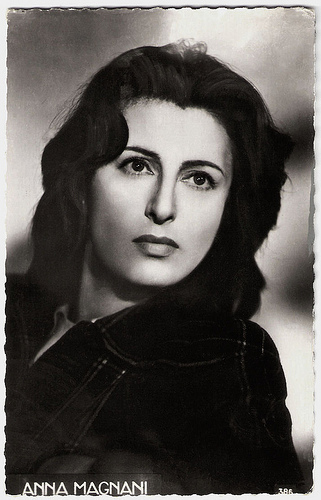
French postcard by Editions P.I., Paris, no. 386.
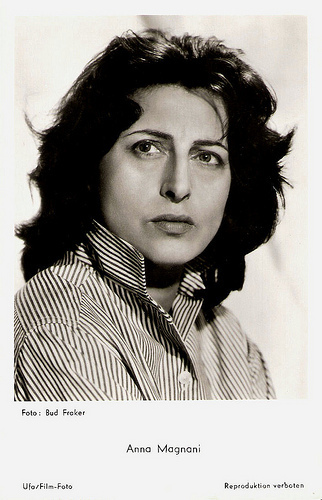
German postcard by Ufa, Berlin-Tempelhof, no. FK 4136. Photo: Bud Fraker.
The Italian Edith Piaf
Anna Magnani was born in Rome in 1908. She was the illegitimate child of Marina Magnani and an unknown father, whom Anna herself claimed was from the Calabria region of Italy (according to Wikipedia he was called Francesco Del Duce). She was raised by her maternal grandmother in a slum district of Rome after her mother left her.
At 14, she enrolled in a French convent school in Rome, where, she learned to speak French and play piano. She also developed a passion for acting from watching the nuns stage their Christmas play.
At age 17, she went on to study at Santa Cecilia's Corso Eleanora Duse (the Eleanora Duse Royal Academy of Dramatic Art) in Rome. To support herself, Magnani sang bawdy Roman songs in nightclubs and cabarets leading to her being dubbed ‘the Italian Edith Piaf’.
She began touring the countryside with small repertory companies, and had a small role in the silent film Scampolo (Augusto Genina, 1928) starring Carmen Boni .
In 1933 she was acting in experimental plays in Rome when she was discovered by Italian filmmaker Goffredo Alessandrini. She played in La Cieca di Sorrento/The Blind Woman of Sorrento (Nunzio Malasomma, 1934). They married in 1933, shortly before the film was released. Magnani retired from full-time acting to devote herself exclusively to her husband, although she continued to play smaller film parts.
Under Alessandrini, she next appeared in Cavalleria/Cavalry (Goffredo Alessandrini, 1936) with Amedeo Nazzari , followed by La principessa Tarakanova/Betrayal (Fyodor Otsep, Mario Soldati, 1938) featuring Annie Vernay . Alessandrini and Magnani separated in 1942 and finally divorced in 1950.
After their separation her son Luca was born, the result of a brief affair with Italian matinée idol Massimo Serato. Magnani's life was struck by tragedy when Luca came down with crippling polio at only 18 months of age. He never regained use of his legs. As a result, she spent most of her early earnings for specialists and hospitals.
In 1941, Magnani played the second female lead in the comedy of errors Teresa Venerdì/Do You Like Women (Vittorio De Sica, 1941) which writer-director Vittorio De Sica called Magnani’s ‘first true film’. In it she plays Loletta Prima, the girlfriend of Di Sica’s character, Pietro Vignali. But her international breakthrough role had still to come.
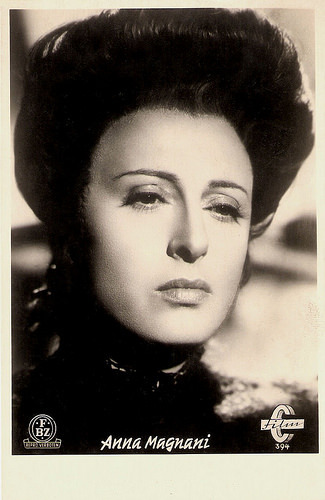
German postcard by FBZ, no. 394. Photo: Cfilm.
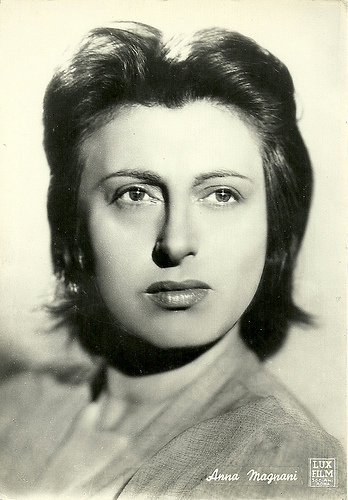
Italian postcard by Bromofoto, Milano, no. 104. Photo: Lux Film, Rome.
One of Cinema's Most Devastating Moments
Anna Magnani’s film career had spread over 18 years before she gained international renown as Pina in the neorealist milestone Roma, città aperta/Rome, Open City (Roberto Rossellini, 1945) about the final days of the Nazi occupation of Rome.
Magnani gave a brilliant performance as a woman who dies fighting to protect her husband, an underground fighter against the Nazis. Her harrowing death scene remains one of cinema's most devastating moments.
It established her as a star, although she lacked the conventional beauty and glamour often associated with the term. Slightly plump and rather short in stature with a face framed by unkempt raven hair and eyes encircled by deep, dark shadows, she smouldered with seething earthiness and volcanic temperament.
Roberto Rossellini was her lover at the time, and she collaborated with him on other films, including L'Amore/Love (Roberto Rossellini, 1948) a two part film including Il miracolo/The Miracle and Una voce umana/The Human Voice. In the former, she played a pregnant outcast peasant who was seduced by a stranger and comes to believe the child she subsequently carries is Christ. Magnani plumbs both the sorrow and the righteousness of being alone in the world. The latter film is based on Jean Cocteau's play about a woman desperately trying to salvage a relationship over the telephone. It is remarkable for the ways in which Magnani's powerful moments of silence segue into cries of despair.
Rossellini promised to direct her again in Stromboli, the next film he was preparing. However, when the screenplay was completed, he gave the role to Ingrid Bergman . This and his affair with the Swedish Hollywood star caused Magnani's breakup with Rossellini. As a result, she took on the starring role of Volcano/Vulcano (William Dieterle, 1949) with Rossano Brazzi , which was deliberately produced to invite comparison.
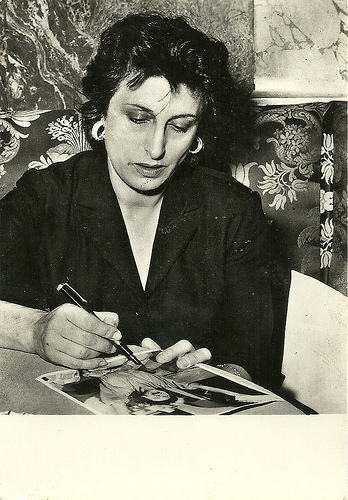
Italian postcard in the Series 'Hobby' by Bromostampa, Milano.
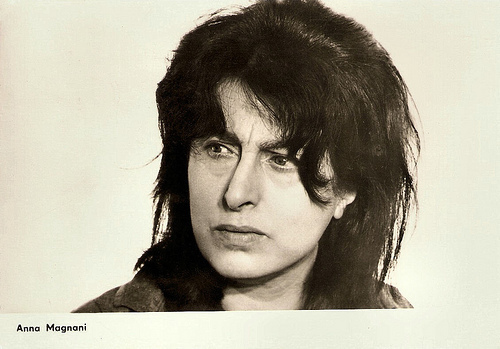
East-German postcard by VEB Progress Film-Vertrieb, Berlin, no. 2823, 1967. Sent by mail in East-Germany in 1974.
Prostitutes and Suffering Mothers
In 1950, Life magazine stated that Anna Magnani was "one of the most impressive actresses since Garbo." In Bellissima (Luchino Visconti, 1951) she played Maddalena, a blustery, obstinate stage mother who drags her daughter to Cinecittà for the 'Prettiest Girl in Rome' contest, with dreams that her plain daughter will be a star. Her emotions in the film went from those of rage and humiliation to maternal love.
She later starred as Camille, a commedia dell'arte actress torn between three men, a soldier, a bullfighter, and a viceroy, in Le Carrosse d'or/The Golden Coach (Jean Renoir, 1953).
In Hollywood she starred opposite Burt Lancaster as Serafina, the widowed mother of a teenage daughter in The Rose Tattoo (Daniel Mann, 1955). Screenwriter and close friend Tennessee Williams had based the character of Serafina on Magnani. He even stipulated that the film must star Magnani. It was Magnani's first English speaking role in a mainstream Hollywood movie, winning her the Academy Award, the BAFTA, the Golden Globe and the New York Film Critics Circle Award for Best Actress.
Magnani worked with Tennessee Williams again on The Fugitive Kind (Sidney Lumet, 1959), co-starring with Marlon Brando. In Hollywood she also appeared in Wild is the Wind (1957, George Cukor), for which she was again nominated for the Academy Award.
In Italy she played strong-willed prostitutes and suffering mothers in such films as the women-in-prison drama Nella città l'inferno/The Wild, Wild Women (Renato Castellani, 1958) with Giulietta Masina , and Mamma Roma (Pier Paolo Pasolini, 1962). In Mama Roma Magnani is both the mother and the whore, playing an irrepressible prostitute determined to give her teenage son a respectable middle-class life. It was controversial but also one of Magnani's most critically acclaimed films.
In this later period of her career, she also appeared on Italian television and acted on the stage, most notably in 1965 when she starred in La Lupa (She-Wolf), directed by Franco Zeffirelli, and in 1966 when she played the lead in Jean Anouilh's Medea, directed by Gian Carlo Menotti.
In the film comedy The Secret of Santa Vittoria (Stanley Kramer, 1969), she co-starred with Anthony Quinn as a fighting husband and wife. Magnani and Quinn did also feud in private and their animosity spilled over into their scenes. Reportedly she bit Quinn in the neck and kicked him so hard she broke a bone in her right foot.
Her final screen performance was a cameo in Fellini's Roma (Federico Fellini, 1972).
In 1973, Anna Magnani died at the age of 65 in Rome, after a long battle with pancreatic cancer. Her son Luca and her favourite director Roberto Rossellini were at her bedside. With Rossellini she'd patched up her disagreements some years before. It was reported that an enormous crowd turned out for her funeral in Italy, in a final public salute that is more typically reserved for Popes.
Scene from The Rose Tattoo (1953). Source: The SuppActress (YouTube).
Anna Magnani sings Scapricciatiello in Wild is the Wind (1957). Source: Minuit (YouTube).
Sources: Jason Ankeny (All Movie), (IMDb), Answers.com, Wikipedia and .

French postcard by Editions P.I., Paris, no. 386.

German postcard by Ufa, Berlin-Tempelhof, no. FK 4136. Photo: Bud Fraker.
The Italian Edith Piaf
Anna Magnani was born in Rome in 1908. She was the illegitimate child of Marina Magnani and an unknown father, whom Anna herself claimed was from the Calabria region of Italy (according to Wikipedia he was called Francesco Del Duce). She was raised by her maternal grandmother in a slum district of Rome after her mother left her.
At 14, she enrolled in a French convent school in Rome, where, she learned to speak French and play piano. She also developed a passion for acting from watching the nuns stage their Christmas play.
At age 17, she went on to study at Santa Cecilia's Corso Eleanora Duse (the Eleanora Duse Royal Academy of Dramatic Art) in Rome. To support herself, Magnani sang bawdy Roman songs in nightclubs and cabarets leading to her being dubbed ‘the Italian Edith Piaf’.
She began touring the countryside with small repertory companies, and had a small role in the silent film Scampolo (Augusto Genina, 1928) starring Carmen Boni .
In 1933 she was acting in experimental plays in Rome when she was discovered by Italian filmmaker Goffredo Alessandrini. She played in La Cieca di Sorrento/The Blind Woman of Sorrento (Nunzio Malasomma, 1934). They married in 1933, shortly before the film was released. Magnani retired from full-time acting to devote herself exclusively to her husband, although she continued to play smaller film parts.
Under Alessandrini, she next appeared in Cavalleria/Cavalry (Goffredo Alessandrini, 1936) with Amedeo Nazzari , followed by La principessa Tarakanova/Betrayal (Fyodor Otsep, Mario Soldati, 1938) featuring Annie Vernay . Alessandrini and Magnani separated in 1942 and finally divorced in 1950.
After their separation her son Luca was born, the result of a brief affair with Italian matinée idol Massimo Serato. Magnani's life was struck by tragedy when Luca came down with crippling polio at only 18 months of age. He never regained use of his legs. As a result, she spent most of her early earnings for specialists and hospitals.
In 1941, Magnani played the second female lead in the comedy of errors Teresa Venerdì/Do You Like Women (Vittorio De Sica, 1941) which writer-director Vittorio De Sica called Magnani’s ‘first true film’. In it she plays Loletta Prima, the girlfriend of Di Sica’s character, Pietro Vignali. But her international breakthrough role had still to come.

German postcard by FBZ, no. 394. Photo: Cfilm.

Italian postcard by Bromofoto, Milano, no. 104. Photo: Lux Film, Rome.
One of Cinema's Most Devastating Moments
Anna Magnani’s film career had spread over 18 years before she gained international renown as Pina in the neorealist milestone Roma, città aperta/Rome, Open City (Roberto Rossellini, 1945) about the final days of the Nazi occupation of Rome.
Magnani gave a brilliant performance as a woman who dies fighting to protect her husband, an underground fighter against the Nazis. Her harrowing death scene remains one of cinema's most devastating moments.
It established her as a star, although she lacked the conventional beauty and glamour often associated with the term. Slightly plump and rather short in stature with a face framed by unkempt raven hair and eyes encircled by deep, dark shadows, she smouldered with seething earthiness and volcanic temperament.
Roberto Rossellini was her lover at the time, and she collaborated with him on other films, including L'Amore/Love (Roberto Rossellini, 1948) a two part film including Il miracolo/The Miracle and Una voce umana/The Human Voice. In the former, she played a pregnant outcast peasant who was seduced by a stranger and comes to believe the child she subsequently carries is Christ. Magnani plumbs both the sorrow and the righteousness of being alone in the world. The latter film is based on Jean Cocteau's play about a woman desperately trying to salvage a relationship over the telephone. It is remarkable for the ways in which Magnani's powerful moments of silence segue into cries of despair.
Rossellini promised to direct her again in Stromboli, the next film he was preparing. However, when the screenplay was completed, he gave the role to Ingrid Bergman . This and his affair with the Swedish Hollywood star caused Magnani's breakup with Rossellini. As a result, she took on the starring role of Volcano/Vulcano (William Dieterle, 1949) with Rossano Brazzi , which was deliberately produced to invite comparison.

Italian postcard in the Series 'Hobby' by Bromostampa, Milano.

East-German postcard by VEB Progress Film-Vertrieb, Berlin, no. 2823, 1967. Sent by mail in East-Germany in 1974.
Prostitutes and Suffering Mothers
In 1950, Life magazine stated that Anna Magnani was "one of the most impressive actresses since Garbo." In Bellissima (Luchino Visconti, 1951) she played Maddalena, a blustery, obstinate stage mother who drags her daughter to Cinecittà for the 'Prettiest Girl in Rome' contest, with dreams that her plain daughter will be a star. Her emotions in the film went from those of rage and humiliation to maternal love.
She later starred as Camille, a commedia dell'arte actress torn between three men, a soldier, a bullfighter, and a viceroy, in Le Carrosse d'or/The Golden Coach (Jean Renoir, 1953).
In Hollywood she starred opposite Burt Lancaster as Serafina, the widowed mother of a teenage daughter in The Rose Tattoo (Daniel Mann, 1955). Screenwriter and close friend Tennessee Williams had based the character of Serafina on Magnani. He even stipulated that the film must star Magnani. It was Magnani's first English speaking role in a mainstream Hollywood movie, winning her the Academy Award, the BAFTA, the Golden Globe and the New York Film Critics Circle Award for Best Actress.
Magnani worked with Tennessee Williams again on The Fugitive Kind (Sidney Lumet, 1959), co-starring with Marlon Brando. In Hollywood she also appeared in Wild is the Wind (1957, George Cukor), for which she was again nominated for the Academy Award.
In Italy she played strong-willed prostitutes and suffering mothers in such films as the women-in-prison drama Nella città l'inferno/The Wild, Wild Women (Renato Castellani, 1958) with Giulietta Masina , and Mamma Roma (Pier Paolo Pasolini, 1962). In Mama Roma Magnani is both the mother and the whore, playing an irrepressible prostitute determined to give her teenage son a respectable middle-class life. It was controversial but also one of Magnani's most critically acclaimed films.
In this later period of her career, she also appeared on Italian television and acted on the stage, most notably in 1965 when she starred in La Lupa (She-Wolf), directed by Franco Zeffirelli, and in 1966 when she played the lead in Jean Anouilh's Medea, directed by Gian Carlo Menotti.
In the film comedy The Secret of Santa Vittoria (Stanley Kramer, 1969), she co-starred with Anthony Quinn as a fighting husband and wife. Magnani and Quinn did also feud in private and their animosity spilled over into their scenes. Reportedly she bit Quinn in the neck and kicked him so hard she broke a bone in her right foot.
Her final screen performance was a cameo in Fellini's Roma (Federico Fellini, 1972).
In 1973, Anna Magnani died at the age of 65 in Rome, after a long battle with pancreatic cancer. Her son Luca and her favourite director Roberto Rossellini were at her bedside. With Rossellini she'd patched up her disagreements some years before. It was reported that an enormous crowd turned out for her funeral in Italy, in a final public salute that is more typically reserved for Popes.
Scene from The Rose Tattoo (1953). Source: The SuppActress (YouTube).
Anna Magnani sings Scapricciatiello in Wild is the Wind (1957). Source: Minuit (YouTube).
Sources: Jason Ankeny (All Movie), (IMDb), Answers.com, Wikipedia and .
Published on December 29, 2014 22:00
December 28, 2014
Eddy Mitchell
French singer and actor Eddy Mitchell (1942) began his career in the late 1950s, with the rock & roll group Les Chaussettes Noires, and in 1963, he went solo. He also played in several French films. In black and white musical comedies of the 1960s he appeared as himself fronting his band, but his ‘real’ acting career started with the Oscar nominated Coup de torchon (1981). Now, after a career of 50 years, Mr. Eddy has become the tranquil daddy of French rock & roll.
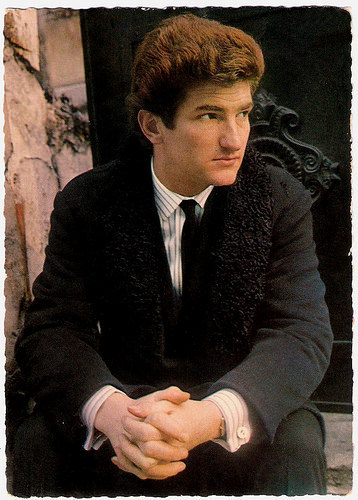
French postcard by Publistar, Marseille, no. 927. Photo: Patrick Bertrand.
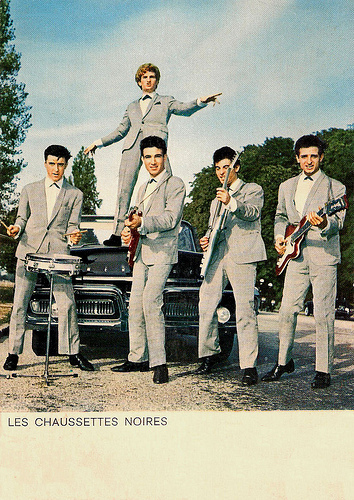
French postcard by Editions Publistar, Marseille, no. 727 C. Photo: Rolland Carré.
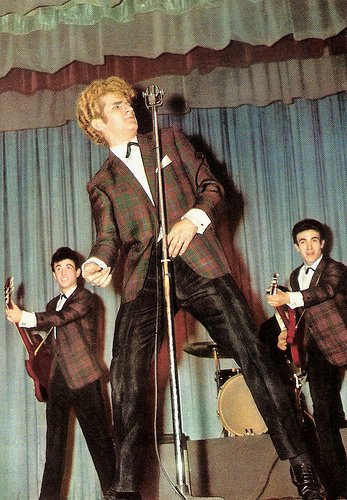
French postcard by Editions P.I., Paris, no. 1079. Photo: Noa.
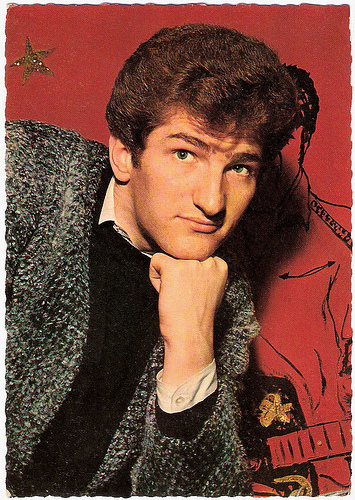
French postcard by PSG, no. 859. Photo: Gérard Neuvecelle.
The Black Socks
Eddy Mitchell was born as Claude Moine in Paris in 1942. He spent his childhood in Belleville, a working class quarter of the capital. His mother worked in a bank and his father was a mechanic at the RATP (the Paris transport authority).
After several years at the Lycée Turgot he obtained his certificate of studies. Only fourteen, he went to work at Crédit Lyonnais. Later he was a motorcycle courier for an insurance company.
At the end of the 1950s, Claude discovered rock & roll, newly arrived from America. His favourite stars were Bill Haley and Gene Vincent. Young people in Paris, eager to hear the new music, began flocking to the now legendary night club, Le Golf Drouot, opened in 1956.
Claude, who became known as ‘Schmoll’, started a group with a friend, Jean-Pierre Chicheportiche, who recruited two more young musicians. After practice sessions and appearances at the Golf Drouot, they began looking around for a record label. Their first audition was with Barclay. The musical director, Jean Fernandez, was impressed.
Claude took his stage name from the American expatriate tough-guy actor Eddie Constantine . By the end of 1960, his group had become Les Chaussettes Noires (The Black Socks). The name was inspired by a publicity campaign for socks made by Lainières de Roubaix, with whom Eddie Constantine had a promotional contract.
The band found almost instant success. In 1961 Les Chaussettes Noires released six singles and sold two million records, including 800,000 copies of Daniela. He also appeared in the film De quoi tu te mêles Daniela!/Daniela, Criminal Strip-Tease (Max Pécas, 1961) starring Elke Sommer .
This bit part was followed by other appearances with Les Chausettes Noires in films like Les parisiennes (Jacques Poitrenaud, 1962) and Une grosse tête/A Fat Head (Claude de Givray, 1962) starring Eddie Constantine .
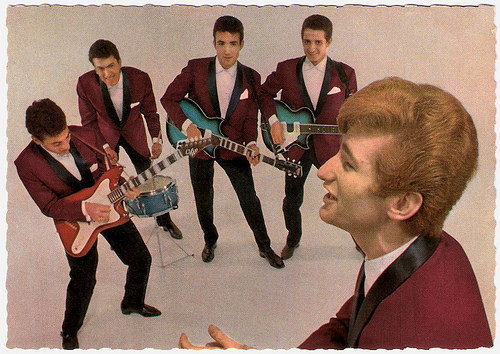
French postcard by E.D.U.G., no. 211. Photo: Herman Leonard / Barclay.
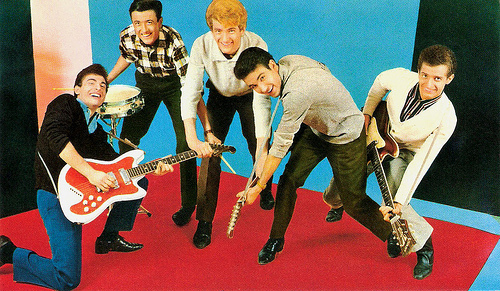
French postcard by E.D.U.G., no. 250, offered by Corvisart. Photo: Roland Carré.
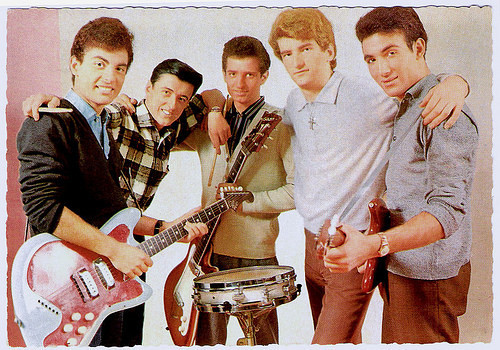
French postcard by E.D.U.G., no. 210. Photo: Roland Carré.
The Rhythm Was Frantic
In March 1962, Eddy Mitchell was called up for his military service, during which he nevertheless found time to record new tracks and play at dances with Les Chaussettes Noires. Jean Fernandez had in mind a solo career for Eddy, whose vocal talents he rated highly.
In November 1962, he recorded a four track EP, Mais reviens-moi. When he finished his military service in August 1963, Eddy Mitchell was able to devote himself entirely to a solo career.
In October he went to London to record new material with English musicians (including the very young Jimmy Page). The result was Eddy in London, an album of cover versions of numbers by his rock & roll heroes, Eddie Cochrane, Elvis Presley, Gene Vincent and Bill Haley.
In 1964, he was back in the London studios again recording a second album, Panorama. The rhythm was frantic. The third solo album, modestly entitled, Toute la ville en parle, Eddy est en ville (The Whole Town Is Talking, Eddy is in Town), came out in 1964. This was the first recording of original material by the singer, who signed lyrics such as Toujours un coin qui me rappelle (Always a Corner Which Reminds Me). Until then he had only sung French adaptations of English lyrics.
After rock & roll, he discovered the soul of James Brown and Otis Redding and changed musical direction. In 1965, his new album, Du rock ‘n’ roll au rhythm & blues (From Rock & Roll to Rhythm & Blues), included titles such as J’avais deux amis (I Had Two Friends) and Si tu n’étais pas mon frère (If You Are Not My Brother). The horn section became more and more prominent, which suited the artist’s stage shows perfectly.
By the mid-sixties, Mitchell was already very different from the other singers of the period, most of whom had climbed on to the yéyé bandwagon. De Londres à Memphis (From London To Memphis) was recorded in 1967, the year Eddy’s dream came true: to record in America, cradle of rock, R&B and country. He came back with a new hit Alice.
Now turned thirty, his career seemed to have taken off for good. Nevertheless, 1968 was the beginning of a lull in his career. Only his hard core fans greeted each new album release with the same old fervour. Meanwhile, Eddy, ever faithful to himself, polished his tranquil rock star persona. None of the six or so albums which he released between 1968 and 1974 sold hugely.
In 1974, Barclay re-released some of the old Chaussette Noires numbers. Unexpectedly, sales of these records rocketed. The defunct band’s leader had the idea of starting it up again. Mitchell refused outright. His solo career quickly took off again with the release of Rocking in Nashville, which went to the Number 1 in the French album charts, where it stayed for several weeks. He returned to the States to record Made in U.S.A. The album was a golden disc in France. Eddy continued recording albums at the rate of one a year.
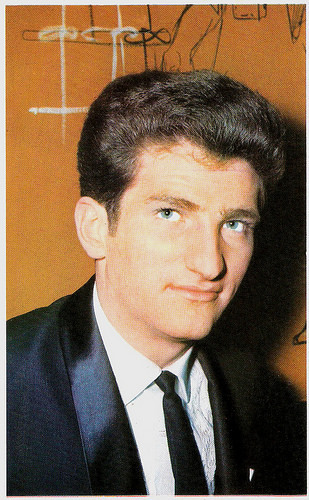
French postcard by Editions P.I., Paris, offered by Corvisart, Epinal, no. 1118. Photo: Anders.
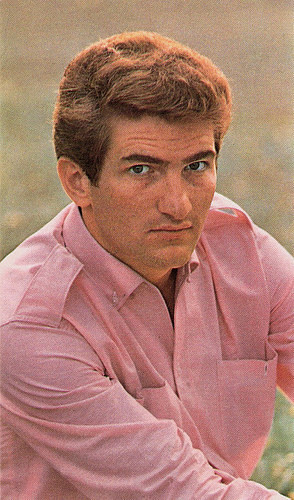
French postcard by PSG, offered by Corvisart, Epinal, no. 1233. Photo: Barclay.
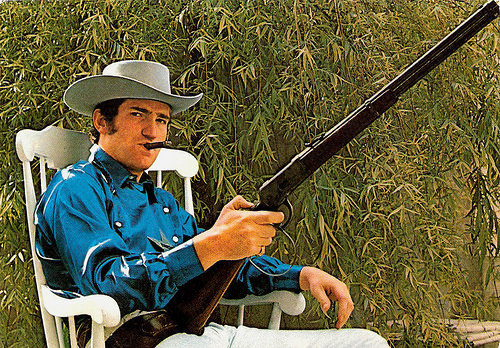
French postcard by Editions Lyna, Paris, no. 2013. Photo: Casanova - Formidable.
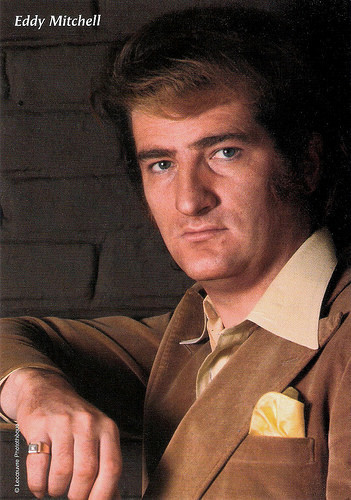
French postcard by Universal Collections, 2003, a limited edition for L'Encyclopédie de la Chanson Française.
Cinema, Music and Television
The new decade began well for Eddy Mitchell. His professionalism was admired by everybody. In 1980 ‘Monsieur Eddy’, as he was now known, celebrated twenty years in the music business with Happy Birthday. The album sold 500.000 copies, thanks to the hit number which has become his signature tune, Couleur menthe à l’eau (Color mint in the water).
After a two year break, he returned to L’Olympia, where he recorded a triple live album. But, at the beginning of the eighties, it was the cinema which seemed to interest him most. Film director Bertrand Tavernier gave him a real chance to prove himself as an actor in Coup de torchon/Clean Slate (Bertrand Tavernier, 1981) starring Philippe Noiret. After watching the dailies Mitchell reportedly thought he was so bad that he insisted to do some of his scenes once again. But no one agreed, and the success of the film led to several more role offers.
In 1982, his love for cinema led him to host and produce, La dernière séance (The last session), a programme entirely devoted to American films from the 1950s on the French television channel, FR3. He hosted this TV show till 1997.
After withdrawing Barclay’s distribution rights, Mitchell signed a contract with RCA in 1983. The first two albums released on this label were respectively a compilation and a collection of previously unreleased recordings.
He appeared in more films, including Attention une femme peut en cacher une autre/My Other Husband (Georges Lautner, 1983) starring Miou-Miou and the thriller A mort l’arbitre/Kill the Referee (Jean-Pierre Mocky, 1984) with Michel Serrault.
In 1984 an album of new material was released: Racines. One of the most accomplished of all his albums, Racines received the Académie Charles Cros award. Again in the nostalgic vein, it included Nashville ou Belleville and Comme quand j’étais môme(As when I was a kid).
From then on he divided his professional life between the cinema, music and television. The variety of activities seemed to suit him perfectly. His films included I Love You (Marco Ferreri, 1986), 'Round Midnight (Bertrand Tavernier, 1986) starring real-life jazz legend Dexter Gordon, and Bis ans Ende der Welt/Until the End of the World (Wim Wenders, 1991) starring William Hurt.
Passing from one to the other, Eddy Mitchell was as at ease in front of the cameras as he was in front of the microphone. He gradually turned into a crooner with the warm, ample voice of a rock singer. After writing P’tit Claude, a collection of short stories about the Belleville quarter of Paris where he grew up, Mitchell acted in the comedy Le bonheur est dans le pré/The happiness is in the meadow (Etienne Chatiliez, 1995), a huge box office success for which he was awarded a César.
He then embarked on a series of recording sessions in Memphis, Nashville and Paris. He kept appearing in films such as the thriller Un printemps à Paris/A Winter in Paris (Jacques Bral, 2006) and Bambou (Didier Bourdon, 2009).
In 2008, he appeared for the first time on a theatre stage with actress Cécile de France in the play Le temps des cerises (Cherry season), for a run of 100 performances at the Théâtre de la Madeleine, in Paris. In 2009, he announced on a TV show that his 2010 tour would be his last, since he wanted to be 'polite to my public', and also so that he could spend more time on his film work and TV production company.
Eddy Michell continues his film career on full speed. Recently he starred as a father suffering from a neurodegenerative disease in Grand depart/Great start (Nicolas Mercier, 2013), in the comedy drama Les petits princes/Little princes (Vianney Lebasque, 2013) and Salaud, on t'aime/Bastard, we love you (Claude Lelouch, 2014) opposite that other French rock & roll legend, Johnny Hallyday.
Les Chaussettes Noires play Je t'aime trop (I Love Too Much) in a Scopitone clip. Source: JoaoScatarino (YouTube).
Eddy Mitchell sings Sur La Route De Memphis (On the Way To Memphis)(1976). Source: Azargoth (YouTube).
French trailer for Coup de torchon/Clean Slate (1981). Source: WorleyClarence (YouTube).
French trailer for A mort l’arbitre/Kill the Referee (1984). Source: Ibena65 (YouTube).
Sources: Radio France International (French), (IMDb), Wikipedia and .

French postcard by Publistar, Marseille, no. 927. Photo: Patrick Bertrand.

French postcard by Editions Publistar, Marseille, no. 727 C. Photo: Rolland Carré.

French postcard by Editions P.I., Paris, no. 1079. Photo: Noa.

French postcard by PSG, no. 859. Photo: Gérard Neuvecelle.
The Black Socks
Eddy Mitchell was born as Claude Moine in Paris in 1942. He spent his childhood in Belleville, a working class quarter of the capital. His mother worked in a bank and his father was a mechanic at the RATP (the Paris transport authority).
After several years at the Lycée Turgot he obtained his certificate of studies. Only fourteen, he went to work at Crédit Lyonnais. Later he was a motorcycle courier for an insurance company.
At the end of the 1950s, Claude discovered rock & roll, newly arrived from America. His favourite stars were Bill Haley and Gene Vincent. Young people in Paris, eager to hear the new music, began flocking to the now legendary night club, Le Golf Drouot, opened in 1956.
Claude, who became known as ‘Schmoll’, started a group with a friend, Jean-Pierre Chicheportiche, who recruited two more young musicians. After practice sessions and appearances at the Golf Drouot, they began looking around for a record label. Their first audition was with Barclay. The musical director, Jean Fernandez, was impressed.
Claude took his stage name from the American expatriate tough-guy actor Eddie Constantine . By the end of 1960, his group had become Les Chaussettes Noires (The Black Socks). The name was inspired by a publicity campaign for socks made by Lainières de Roubaix, with whom Eddie Constantine had a promotional contract.
The band found almost instant success. In 1961 Les Chaussettes Noires released six singles and sold two million records, including 800,000 copies of Daniela. He also appeared in the film De quoi tu te mêles Daniela!/Daniela, Criminal Strip-Tease (Max Pécas, 1961) starring Elke Sommer .
This bit part was followed by other appearances with Les Chausettes Noires in films like Les parisiennes (Jacques Poitrenaud, 1962) and Une grosse tête/A Fat Head (Claude de Givray, 1962) starring Eddie Constantine .

French postcard by E.D.U.G., no. 211. Photo: Herman Leonard / Barclay.

French postcard by E.D.U.G., no. 250, offered by Corvisart. Photo: Roland Carré.

French postcard by E.D.U.G., no. 210. Photo: Roland Carré.
The Rhythm Was Frantic
In March 1962, Eddy Mitchell was called up for his military service, during which he nevertheless found time to record new tracks and play at dances with Les Chaussettes Noires. Jean Fernandez had in mind a solo career for Eddy, whose vocal talents he rated highly.
In November 1962, he recorded a four track EP, Mais reviens-moi. When he finished his military service in August 1963, Eddy Mitchell was able to devote himself entirely to a solo career.
In October he went to London to record new material with English musicians (including the very young Jimmy Page). The result was Eddy in London, an album of cover versions of numbers by his rock & roll heroes, Eddie Cochrane, Elvis Presley, Gene Vincent and Bill Haley.
In 1964, he was back in the London studios again recording a second album, Panorama. The rhythm was frantic. The third solo album, modestly entitled, Toute la ville en parle, Eddy est en ville (The Whole Town Is Talking, Eddy is in Town), came out in 1964. This was the first recording of original material by the singer, who signed lyrics such as Toujours un coin qui me rappelle (Always a Corner Which Reminds Me). Until then he had only sung French adaptations of English lyrics.
After rock & roll, he discovered the soul of James Brown and Otis Redding and changed musical direction. In 1965, his new album, Du rock ‘n’ roll au rhythm & blues (From Rock & Roll to Rhythm & Blues), included titles such as J’avais deux amis (I Had Two Friends) and Si tu n’étais pas mon frère (If You Are Not My Brother). The horn section became more and more prominent, which suited the artist’s stage shows perfectly.
By the mid-sixties, Mitchell was already very different from the other singers of the period, most of whom had climbed on to the yéyé bandwagon. De Londres à Memphis (From London To Memphis) was recorded in 1967, the year Eddy’s dream came true: to record in America, cradle of rock, R&B and country. He came back with a new hit Alice.
Now turned thirty, his career seemed to have taken off for good. Nevertheless, 1968 was the beginning of a lull in his career. Only his hard core fans greeted each new album release with the same old fervour. Meanwhile, Eddy, ever faithful to himself, polished his tranquil rock star persona. None of the six or so albums which he released between 1968 and 1974 sold hugely.
In 1974, Barclay re-released some of the old Chaussette Noires numbers. Unexpectedly, sales of these records rocketed. The defunct band’s leader had the idea of starting it up again. Mitchell refused outright. His solo career quickly took off again with the release of Rocking in Nashville, which went to the Number 1 in the French album charts, where it stayed for several weeks. He returned to the States to record Made in U.S.A. The album was a golden disc in France. Eddy continued recording albums at the rate of one a year.

French postcard by Editions P.I., Paris, offered by Corvisart, Epinal, no. 1118. Photo: Anders.

French postcard by PSG, offered by Corvisart, Epinal, no. 1233. Photo: Barclay.

French postcard by Editions Lyna, Paris, no. 2013. Photo: Casanova - Formidable.

French postcard by Universal Collections, 2003, a limited edition for L'Encyclopédie de la Chanson Française.
Cinema, Music and Television
The new decade began well for Eddy Mitchell. His professionalism was admired by everybody. In 1980 ‘Monsieur Eddy’, as he was now known, celebrated twenty years in the music business with Happy Birthday. The album sold 500.000 copies, thanks to the hit number which has become his signature tune, Couleur menthe à l’eau (Color mint in the water).
After a two year break, he returned to L’Olympia, where he recorded a triple live album. But, at the beginning of the eighties, it was the cinema which seemed to interest him most. Film director Bertrand Tavernier gave him a real chance to prove himself as an actor in Coup de torchon/Clean Slate (Bertrand Tavernier, 1981) starring Philippe Noiret. After watching the dailies Mitchell reportedly thought he was so bad that he insisted to do some of his scenes once again. But no one agreed, and the success of the film led to several more role offers.
In 1982, his love for cinema led him to host and produce, La dernière séance (The last session), a programme entirely devoted to American films from the 1950s on the French television channel, FR3. He hosted this TV show till 1997.
After withdrawing Barclay’s distribution rights, Mitchell signed a contract with RCA in 1983. The first two albums released on this label were respectively a compilation and a collection of previously unreleased recordings.
He appeared in more films, including Attention une femme peut en cacher une autre/My Other Husband (Georges Lautner, 1983) starring Miou-Miou and the thriller A mort l’arbitre/Kill the Referee (Jean-Pierre Mocky, 1984) with Michel Serrault.
In 1984 an album of new material was released: Racines. One of the most accomplished of all his albums, Racines received the Académie Charles Cros award. Again in the nostalgic vein, it included Nashville ou Belleville and Comme quand j’étais môme(As when I was a kid).
From then on he divided his professional life between the cinema, music and television. The variety of activities seemed to suit him perfectly. His films included I Love You (Marco Ferreri, 1986), 'Round Midnight (Bertrand Tavernier, 1986) starring real-life jazz legend Dexter Gordon, and Bis ans Ende der Welt/Until the End of the World (Wim Wenders, 1991) starring William Hurt.
Passing from one to the other, Eddy Mitchell was as at ease in front of the cameras as he was in front of the microphone. He gradually turned into a crooner with the warm, ample voice of a rock singer. After writing P’tit Claude, a collection of short stories about the Belleville quarter of Paris where he grew up, Mitchell acted in the comedy Le bonheur est dans le pré/The happiness is in the meadow (Etienne Chatiliez, 1995), a huge box office success for which he was awarded a César.
He then embarked on a series of recording sessions in Memphis, Nashville and Paris. He kept appearing in films such as the thriller Un printemps à Paris/A Winter in Paris (Jacques Bral, 2006) and Bambou (Didier Bourdon, 2009).
In 2008, he appeared for the first time on a theatre stage with actress Cécile de France in the play Le temps des cerises (Cherry season), for a run of 100 performances at the Théâtre de la Madeleine, in Paris. In 2009, he announced on a TV show that his 2010 tour would be his last, since he wanted to be 'polite to my public', and also so that he could spend more time on his film work and TV production company.
Eddy Michell continues his film career on full speed. Recently he starred as a father suffering from a neurodegenerative disease in Grand depart/Great start (Nicolas Mercier, 2013), in the comedy drama Les petits princes/Little princes (Vianney Lebasque, 2013) and Salaud, on t'aime/Bastard, we love you (Claude Lelouch, 2014) opposite that other French rock & roll legend, Johnny Hallyday.
Les Chaussettes Noires play Je t'aime trop (I Love Too Much) in a Scopitone clip. Source: JoaoScatarino (YouTube).
Eddy Mitchell sings Sur La Route De Memphis (On the Way To Memphis)(1976). Source: Azargoth (YouTube).
French trailer for Coup de torchon/Clean Slate (1981). Source: WorleyClarence (YouTube).
French trailer for A mort l’arbitre/Kill the Referee (1984). Source: Ibena65 (YouTube).
Sources: Radio France International (French), (IMDb), Wikipedia and .
Published on December 28, 2014 22:00
December 27, 2014
Michael Praed
British stage and film actor Michael Praed (1960) is best known for his roles in the TV series Robin of Sherwood (1984-1985) and Dynasty (1985-1986). He also appeared in several British and American films, but somehow his promising film career went nowhere.
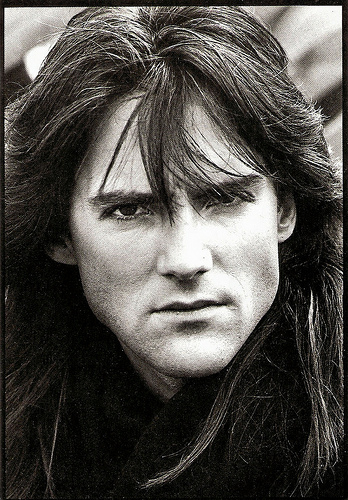
British postcard by Santoro Graphics, London, no. BW 133.
Robin of Loxley
Michael Praed was born as Michael David Prince in Berkeley, England in 1960. His parents were Derrick and Kay Prince, with whom he spent his early years in Iran because his father worked as an accountant for a petroleum company.
Michael was sent back to England for a public school education, which he did not enjoy. He then attended the Guildhall School of Music and Drama in London. As there was already a Michael Prince listed in Equity, Michael chose the surname ‘Praed’ from the phone book.
He began his career in repertory theatre before moving on to roles in London's West End. Praed's first big break occurred in playing in Joseph Papp's 1982 revival of The Pirates of Penzance with Tim Curry in the West End.
The producers of the TV series Robin of Sherwood spotted Praed and cast him as Robin of Loxley a.k.a. Robin Hood. The BAFTA winning Robin of Sherwood (1984-1985) was a huge hit and gained an international cult status.
After two successful seasons as Robin, Praed was lured to Broadway to star in The Three Musketeers. His Broadway adventure led to him being cast as Prince Michael of Moldavia in Aaron Spelling's prime time soap Dynasty (1985-1986).
After this, Praed starred in the SciFi horror Nightflyers (Robert Collector, 1986), Writer's Block (Charles Correll, 1991), and Son of Darkness: To Die For II (David Price, 1991). Between these B-films, Michael Praed worked on writing and recording music in his own studio.

British postcard by Reflex, Watford, no. PC 153, 1985. Photo: Brian Aris.
Phileas Fogg
At the end of 1991, Michael Praed left Los Angeles for the lead in an Irish production of the classic musical Carousel. Immediately following this Rogers and Hammerstein musical, he found himself back in London playing the lead in the West End production of Aspects of Love by Andrew Lloyd Webber.
The British televised mini-series Riders (Gabrielle Beaumont, 1993) followed, based a novel by Jilly Cooper.
His next stage endeavour was Harold Pinter's terse, tense drama The Caretaker. In 1994 he starred opposite Susannah York in the drama September Tide in the West End.
Praed then dived into the role of the devious, womanizing Gary in the comedy film Staggered (Martin Clunes, 1994). Subsequently, he accepted a regular role in the British television series Crown Prosecutor (John Stroud, 1995).
In 1995, he returned once again to the West End for Noel Coward's Design for Living with Rachel Weisz. Praed was brought as a replacement in the last two weeks of the run and learned the three act play over a single weekend. The next year he played the lead in Barry Manilow's Copacabana: The Musical, on its first national tour of Britain.
Praed made a cameo as the Hitman in the film Darkness Falls (Gerry Lively, 1999) with Robin of Sherwood comrade Ray Winstone. In Canada, he took the regular role of the Victorian aristocrat Phileas Fogg in the Canadian television series The Secret Adventures of Jules Verne (Gavin Scott, 2000), which developed a devoted following.
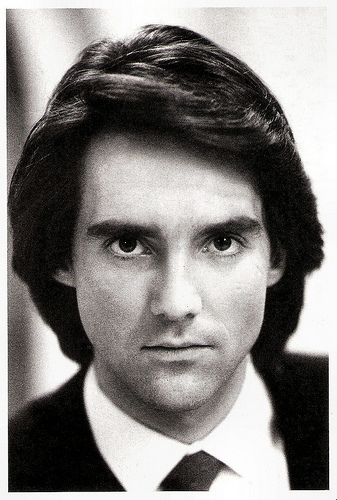
British postcard by Statics, London, no. PC 81.
Captain Von Trapp
Michael Praed played The Queen in the film comedy 9 Dead Gay Guys (Lab Ky Mo, 2002), which was shunned at Cannes but won awards at other, smaller festivals.
His next appearance was in Susan Stroman's Tony Award winning musical Contact back in London's West End (2003). He also appeared in such stage productions as Somerset Maugham's The Constant Wife, the musical Beautiful and Damned, Misery with Susan Penhaligon and in Anthony Shaffer's Sleuth.
On TV Praed was seen in popular series as Casualty (2002-2003) and The Bill (2005). Along with his acting, Praed has also recorded a number of narrations. In 2007, Praed was a cast member of the Blake's 7 audio adventure Rebel for B7 Media. He portrayed passenger Nelson Morris in the docudrama Hindenburg: Titanic of the Skies (Sean Grundy, 2007) a re-examination of the German zeppelin's spectacular explosion over New Jersey on the eve of World War II. He has also been the regular narrator of Timewatch (2003-2009), BBC TV's award winning documentary series.
Michael Praed was married to Karen Landau from 1994 till their divorce in 2009. They have two children, son Gabriel (1994) and daughter Frankie (1996). In recent years, appeared on stage as Captain Von Trapp in The Sound of Music (2009–2011), as Dexter Haven in High Society (2013) and as John Greenwood in The White Carnation (2014).
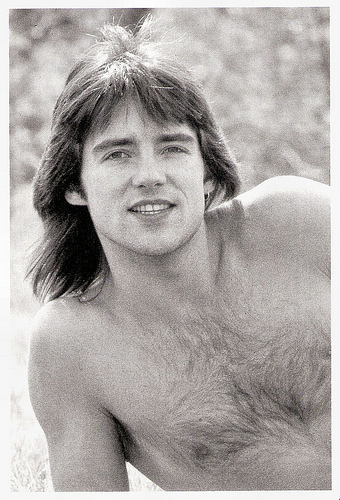
British postcard by Statics, London, no. PC 80.
Sources: Wikipedia and

British postcard by Santoro Graphics, London, no. BW 133.
Robin of Loxley
Michael Praed was born as Michael David Prince in Berkeley, England in 1960. His parents were Derrick and Kay Prince, with whom he spent his early years in Iran because his father worked as an accountant for a petroleum company.
Michael was sent back to England for a public school education, which he did not enjoy. He then attended the Guildhall School of Music and Drama in London. As there was already a Michael Prince listed in Equity, Michael chose the surname ‘Praed’ from the phone book.
He began his career in repertory theatre before moving on to roles in London's West End. Praed's first big break occurred in playing in Joseph Papp's 1982 revival of The Pirates of Penzance with Tim Curry in the West End.
The producers of the TV series Robin of Sherwood spotted Praed and cast him as Robin of Loxley a.k.a. Robin Hood. The BAFTA winning Robin of Sherwood (1984-1985) was a huge hit and gained an international cult status.
After two successful seasons as Robin, Praed was lured to Broadway to star in The Three Musketeers. His Broadway adventure led to him being cast as Prince Michael of Moldavia in Aaron Spelling's prime time soap Dynasty (1985-1986).
After this, Praed starred in the SciFi horror Nightflyers (Robert Collector, 1986), Writer's Block (Charles Correll, 1991), and Son of Darkness: To Die For II (David Price, 1991). Between these B-films, Michael Praed worked on writing and recording music in his own studio.

British postcard by Reflex, Watford, no. PC 153, 1985. Photo: Brian Aris.
Phileas Fogg
At the end of 1991, Michael Praed left Los Angeles for the lead in an Irish production of the classic musical Carousel. Immediately following this Rogers and Hammerstein musical, he found himself back in London playing the lead in the West End production of Aspects of Love by Andrew Lloyd Webber.
The British televised mini-series Riders (Gabrielle Beaumont, 1993) followed, based a novel by Jilly Cooper.
His next stage endeavour was Harold Pinter's terse, tense drama The Caretaker. In 1994 he starred opposite Susannah York in the drama September Tide in the West End.
Praed then dived into the role of the devious, womanizing Gary in the comedy film Staggered (Martin Clunes, 1994). Subsequently, he accepted a regular role in the British television series Crown Prosecutor (John Stroud, 1995).
In 1995, he returned once again to the West End for Noel Coward's Design for Living with Rachel Weisz. Praed was brought as a replacement in the last two weeks of the run and learned the three act play over a single weekend. The next year he played the lead in Barry Manilow's Copacabana: The Musical, on its first national tour of Britain.
Praed made a cameo as the Hitman in the film Darkness Falls (Gerry Lively, 1999) with Robin of Sherwood comrade Ray Winstone. In Canada, he took the regular role of the Victorian aristocrat Phileas Fogg in the Canadian television series The Secret Adventures of Jules Verne (Gavin Scott, 2000), which developed a devoted following.

British postcard by Statics, London, no. PC 81.
Captain Von Trapp
Michael Praed played The Queen in the film comedy 9 Dead Gay Guys (Lab Ky Mo, 2002), which was shunned at Cannes but won awards at other, smaller festivals.
His next appearance was in Susan Stroman's Tony Award winning musical Contact back in London's West End (2003). He also appeared in such stage productions as Somerset Maugham's The Constant Wife, the musical Beautiful and Damned, Misery with Susan Penhaligon and in Anthony Shaffer's Sleuth.
On TV Praed was seen in popular series as Casualty (2002-2003) and The Bill (2005). Along with his acting, Praed has also recorded a number of narrations. In 2007, Praed was a cast member of the Blake's 7 audio adventure Rebel for B7 Media. He portrayed passenger Nelson Morris in the docudrama Hindenburg: Titanic of the Skies (Sean Grundy, 2007) a re-examination of the German zeppelin's spectacular explosion over New Jersey on the eve of World War II. He has also been the regular narrator of Timewatch (2003-2009), BBC TV's award winning documentary series.
Michael Praed was married to Karen Landau from 1994 till their divorce in 2009. They have two children, son Gabriel (1994) and daughter Frankie (1996). In recent years, appeared on stage as Captain Von Trapp in The Sound of Music (2009–2011), as Dexter Haven in High Society (2013) and as John Greenwood in The White Carnation (2014).

British postcard by Statics, London, no. PC 80.
Sources: Wikipedia and
Published on December 27, 2014 23:00
Paul van Yperen's Blog
- Paul van Yperen's profile
- 13 followers
Paul van Yperen isn't a Goodreads Author
(yet),
but they
do have a blog,
so here are some recent posts imported from
their feed.



